00352 - 27 28 15 38 | mycon@mycon.lu
BEST PRACTICE GUIDE ON ASBESTOS
TABLE OF CONTENTS
4 MATERIALS CONTAINING ASBESTOS
4.1 Introduction
4.2 What needs to be done
5 RISK ASSESSMENT AND WORK PLAN BEFORE CARRYING OUT THE WORK
5.1 Introduction
5.2 What to do
5.3 Sample Work Plan Checklist
6.1 Decisions needed
6.2 Guide to decisions on asbestos-containing materials in buildings
6.3 Decisions on the obligation to report work
7.1 Introduction
7.2 Content of the training
7.3 Training programme - your task
7.4 Information
8.1 Equipment required
8.2 Maintenance of equipment
8.3 Your mission
9 GENERAL PRINCIPLES FOR MINIMISING EXPOSURE
9.1 General considerations
9.2 Your mission
10 WORK THAT MAY INVOLVE EXPOSURE TO ASBESTOS
11 LOW-RISK WORK WITH ASBESTOS
11.1 Definition of low risk work
11.2 General procedures for low risk work
11.3 Examples of low risk work
12 NOTIFIABLE WORKS WITH ASBESTOS
12.1 Introduction
12.2 General procedures for notifiable works
12.3 Enclosure for the execution of asbestos removal works
12.4 Decontamination of persons
12.5 Dust suppression techniques
12.6 Encapsulation and housing
12.7 Inspection, monitoring and maintenance of the enclosure
12.8 Waste disposal
12.9 Cleaning and completion of work
14 THE EMPLOYEE AND THE WORKING ENVIRONMENT
14.1 Introduction
14.2 The employee
14.3 The nature of the work
14.4 The working environment
15.1 Introduction
15.2 Problems
15.3 Registration of transport
15.4 Duties of the employee
16.1 Introduction
16.2 Indoor air sampling and sample analysis methods
16.3 Air monitoring objectives
16.4 Selecting a monitoring organisation
16.5 What needs to be done
16.6 Information
17.1 Who else is involved?
17.2 Involvement in asbestos work planning
17.3 Retained asbestos-containing materials
17.4 References
17.5 Was sie tun sollten
18 ASBESTOS IN OTHER PLACES (VEHICLES, MACHINERY, ETC.)
18.1 Introduction
18.2 A variety of applications
18.3 Procedures to avoid exposure to asbestos
18.4 Problems in special cases
FOREWORD
The European Conference on Asbestos Risk, held in Dresden in 2003 and attended by representatives from many European countries, the European Commission and the ILO, drew attention to the fact that asbestos remains the most important toxic carcinogen in the workplace in most countries. With an estimated 20,000 deaths from lung cancer and 10,000 cases of mesothelioma per year in the industrialized countries of Western Europe, North America and Japan, it is clear that asbestos exposure remains a major health problem that must be put back on the agenda and given top priority in our prevention activities. Asbestos remains at the heart of all measures to safeguard workers' health.
In accordance with European legislation, the marketing and use of products or substances containing asbestos was prohibited from January 2005 (Directive 1999/77/EC). Even stricter measures to protect workers against the risk of exposure to asbestos fibres have been in force since 15 April 2006 (Directive 2003/18/EC, which supplements Directive 83/477/EEC). However, despite this legal framework, in practice, the problem of preventing exposure to asbestos during removal, demolition, maintenance or servicing activities remains. Furthermore, in times of close economic ties and globalisation, we must be careful not to thwart our efforts by re-importing asbestos-containing materials.
In line with the recommendations of the Dresden Declaration, the Senior Labour Inspectors Committee (SLIC) set up a working group to develop guides to good practice for activities involving the risk of exposure to asbestos and to conduct a European campaign in 2006 to monitor the implementation of the relevant directives.
The "Best Practice Guide
helps to identify and raise awareness of the presence of asbestos and asbestos products in the use, maintenance and repair of installations, equipment and buildings
describes best practice for asbestos disposal (including dust suppression, dust containment and protective equipment) and for the handling of asbestos cement products and waste.
supports an approach to protective equipment and clothing that takes into account human factors and individual differences
It will be made available to employers and workers.
The labour inspection campaign will be carried out during the second half of 2006 in all EU Member States to protect the health of workers in all work involving the maintenance, demolition, removal or disposal of asbestos-containing materials. Inspections will be carried out by national labour inspectorates (and health authorities if they are competent). The objective of the campaign is to support the implementation of Directive 2003/18/EC (which complements Directive 83/477/EEC), which should be implemented by all EU Member States by 15 April 2006. The inspection campaign is preceded by information and education activities.
For our partners outside Europe, the labour inspectorates of the EU Member States offer their support. Existing SLIC training materials, 2006 campaign materials and good practice guides can be used in any other country wishing to address the health risks associated with asbestos and its use. For this purpose, ILO Convention 162 can be used as a minimum standard. This Convention and the examples of best practice represent the minimum level below which the international community should not fall.
Dear reader,
This "Practical guide to best practice in the prevention or reduction of risks from asbestos in work involving (or likely to involve) asbestos" is the result of a joint collaboration between the Senior Labour Inspectors Committee (SLIC) and the employers' and workers' representatives on the Advisory Committee on Safety and Health of the EU Committee and represents a further step towards the abandonment of asbestos in European workplaces. We hope you will read this guide and keep it to hand.
The main target groups are employers, workers and labour inspectors.
- For the employer, the guide provides information on the latest technical, organisational and personal safety and health measures that the employer is required to implement.
- For the worker, the guide provides information on protective measures, focusing on the key points where
the worker must be trained and motivated to actively contribute to safe and healthy working conditions.
and not harmful to health. - For the labour inspector, the guide describes the main aspects to be examined during the inspection visit.
The guide is complemented by a dedicated website of the European Agency for Safety and Health at Work where you will find additional information and specific links to national health and safety websites concerning the risk of exposure to asbestos.
In addition to its use in the 2006 asbestos inspection campaign, the guide aims to provide a common European basis of good practice for all those involved in work-related asbestos exposure.
exposure to asbestos, the guide aims to provide a common European basis for best practice.
| Dr Bernhard Brückner Deputy Director Department of Health and Safety Place of work Hessian Ministry of Social Affairs Germany | Mr Jose-Ramon Biosca de Sagastuy Head of Institution Head of Institution DG Labour, Social Affairs and Equal Opportunities Health, safety and hygiene at work Luxembourg |
1. INTRODUCTION
This guide has been developed by the Senior Labour Inspectors Committee (SLIC) in collaboration with the Social Partners' Advisory Committee on Safety and Health (ACSH) (representatives of trade unions and employers) with the aim of providing labour inspectors, employers and workers across Europe with a common source of information accessible to all. Developed to support the 2006 asbestos campaign, this guide should continue to be useful in the future. It should therefore evolve with future advances in best practice.
The scope of this guide is ambitious in that information is presented on three scenarios:
- Work in which asbestos may be involved (e.g. in buildings where there is a risk of unexpected discovery of asbestos due to incomplete documentation or incomplete removal).
- Work where low exposure to asbestos dust is expected.
- Work involving an increased risk of exposure to asbestos dust and carried out by specialist companies.
For this reason, the guide includes several chapters relating to all three scenarios, as well as specific chapters on each scenario.
- Chapters 1 to 4 provide basic information. These chapters describe what asbestos is, its health effects, the materials containing asbestos and where they are found.
- Chapters 5 to 7 describe the planning and preparatory work to be carried out before the work is carried out, for example: risk assessment; preparation of written instructions (or the work plan); the process for deciding what work to carry out and whether it should be considered notifiable; whether medical surveillance is required; training of personnel
- Chapters 8 to 12 describe the practical organisation for carrying out work where workers are or may be exposed to asbestos. Chapter 8 describes the equipment required, Chapter 9 describes the general approach to asbestos control, Chapter 10 describes the codes of practice for maintenance work where there is a risk of exposure to asbestos, Chapter 11 describes the codes of practice for low risk work and Chapter 12 describes the codes of practice for notifiable asbestos work (e.g. asbestos disposal).
- Chapters 13 to 18 deal with specific aspects: demolition work (Chapter 13), the worker and the working environment (Chapter 14), waste management (Chapter 15), monitoring and measurement (Chapter 16), other persons with special functions, e.g. the client, architects and facility managers (Chapter 17), and asbestos in other situations, e.g. in vehicles and machinery (Chapter 18).
Chapter 19 describes medical surveillance
Working with asbestos can involve working at great heights, in high temperatures and with cumbersome and restrictive protective equipment. As this guide focuses on the prevention of health risks from asbestos, it should be noted that other risks (e.g. falls from height, possibly due to a friable asbestos cement roof) should not be ignored.
As regards technical rules and practices to control and minimise the risks related to exposure to asbestos, there are marked differences in approach between the Member States. In general, each approach has certain advantages and disadvantages. This guide provides explanations and clarifications on the different methods that could be considered as "best practice" for a particular approach and situation.
To select the methods to be included in the guide, the following criteria were used:
- the method is reliable and proven
- the method takes into account the characteristics of the different action instructions and should therefore theoretically be the best method
- the method is the best method in the given circumstances
- Progress in the state of work
In preparing the guide, care has been taken to make it as concise and readable as possible and to avoid repetition. For this reason, there are some cross-references between different sections, for example, to explain only once the considerations for the selection and use of protective clothing.
In a concise guide covering a wide range of practical work, details may be omitted. These omissions should not be interpreted as a deliberate exclusion of other measures.
Directive 2003/18/EC (Protection of workers from the risks related to exposure to asbestos at work), which supplements Directive 83/477/EEC, has been implemented in the Member States by national legislation, the practical details of which may vary. This guide is intentionally presented as non-mandatory in order to offer best practice advice without specifying whether best practice is a mandatory requirement under the national legislation of EU Member States. Annex 1 provides a list of relevant national legislation submitted by each Member State.
As this guide focuses on the prevention of risks related to asbestos exposure, it does not claim to cover the requirements of Directive 92/57/EEC on health and safety on temporary or mobile construction sites. For example, in addition to sanitary facilities for the decontamination of persons, adequate rest rooms must be provided, as for all work on temporary or mobile sites. Where a health and safety plan is required under the Health and Safety Directive for temporary or mobile work sites, it must include safe and secure working conditions.
procedures for working with asbestos and documentation of asbestos on site (e.g. disposal certificate).
This guide contains advice specifically for the employer, the employee and the labour inspector. However, readers are likely to find the advice for others informative as well. A chapter has also been included specifically for other groups of people involved in asbestos work, for example, clients contracting for asbestos removal, or people occupying a building after asbestos removal, or health and safety advisers.
The guide aims to give practical advice on removing and reducing exposure to asbestos dust. It focuses on good and best practice for reducing exposure to asbestos.
2 ASBESTOS
Asbestos is the fibrous form of several naturally occurring minerals. The main forms are :
- Chrysotile (white asbestos)
- Crocidolite (blue asbestos)
- Amosite (brown asbestos)
- Actinolite
- Anthophylite
- Tremolite
The first three forms were the main forms of asbestos used in commerce. Although they are known by their colour, they cannot be reliably identified by their colour alone. Laboratory analysis is required for this purpose.
Asbestos can be present in a range of products (see Chapter 4). If fibres can be released, there is a danger of inhaling asbestos fibres in the air we breathe. The microscopic fibres can be deposited in the lungs, remain there for many years and cause disease years later, usually decades.
The weak attachment of asbestos fibres in the product or material due to the brittleness or condition of the product/material increases the risk of fibre release. However, if the fibres are firmly bound to a material that is not brittle, fibre release is less likely. Procedural rules have been introduced in several EU Member States that give priority to the disposal of asbestos-containing materials that are considered more hazardous.
All forms of asbestos have been classified as class 1 carcinogens, which means that they cause cancer in humans. EU Directive 2003/18/EC (Protection of workers from the risks related to exposure to asbestos at work), which supplements Directive 83/477/EEC, requires that workers' exposure to all types of asbestos should not exceed 0.1 fibres/ml. Exposure to all types of asbestos must be reduced to a minimum and must in any case be below the limit value.
Some Member States require that the type of asbestos be taken into account when deciding the priority of a hazard. For example, epidemiological evidence indicates that for a given fibre concentration (measured by the standard workplace method) crocidolite is more dangerous than amosite, which in turn is more dangerous than chrysotile. However, this does not change the practical need to apply best practice to avoid exposure to asbestos.
This guide provides practical advice on how to avoid or minimise exposure to asbestos.
The annual consumption of asbestos in Europe has changed considerably during the 20th century, as shown in Figure 2.1. The data (for consumption in more than 27 European countries according to Virta (2003)) clearly show that consumption increased sharply from about 1950 to 1980, and then decreased when some Member States introduced restrictions on the use of asbestos or banned it completely. The bans introduced by the EU directives in the 1990s accelerated the phase-out of asbestos. A complete ban on the use and marketing of asbestos-containing products (as a result of EU Directive 1999/77/EC) came into force on 1 January 2005. The ban on asbestos mining and the ban on the manufacture and processing of products containing asbestos (following Directive 2003/18/EC) came into force in April 2006. Therefore, the asbestos problems that persist in Europe can be attributed to asbestos in buildings, installations or equipment.
There are also significant differences between the EU Member States. Some countries reduced the use of asbestos from around 1980, while others continued to use it until the end of the century.
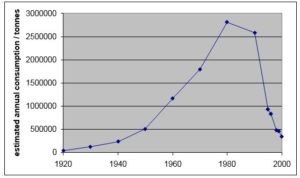
Fig. 2.1 Estimated total asbestos consumption in Europe from 1920 to 2000 (Data source : Virta (2003))

Fig. 2.2 Scanning electron micrograph showing chrysotile fibres

Fig. 2.3 Scanning electron micrograph showing amosite fibres
Asbestos is dangerous because the very fine fibres are not visible to the naked eye. Inhaling these fine asbestos fibres can lead to one of three diseases
- asbestosis, a scarring of the lung tissue
- Lung cancer
- Mesothelioma, a cancer of the pleura (pleura: the thin, slippery skin covering the lungs) or the peritoneum (peritoneum: the slippery skin covering the abdomen).
Asbestosis impairs breathing and can contribute to death. Lung cancer leads to death in about 95 % of cases. Asbestosis can also be followed by lung cancer. Mesothelioma is not curable and usually results in death within 12-18 months of diagnosis.
It has been suggested that exposure to asbestos can lead to laryngeal cancer or gastrointestinal cancer. Oral ingestion of asbestos fibres (e.g. in contaminated drinking water) has been suspected as a cause of gastrointestinal cancer, and at least one study has shown an increased risk due to abnormally high concentrations of asbestos fibres ingested through drinking water. However, these suspicions have not been (systematically) supported by the results of relevant studies.
Exposure to asbestos fibres can also lead to pleural plaques. These are discrete thickened, fibrous or partially calcified areas on the surface of the pleura, which can be detected on an X-ray or CT scan. Deposits on the pleura are not malignant and do not usually lead to limitation of lung function.
In Europe, there are thousands of deaths from asbestos-related diseases every year. At a conference on asbestos in 2003 (organised at the instigation of the EU Senior Labour Inspectors Committee (SLIC)), the likely number of deaths per year in a total of seven European countries (UK, Belgium, Germany, Switzerland, Norway, Poland, Estonia) was estimated to be around 15,000.
http://www.hvbg.de/e/asbest/konfrep/konfrep/repbeitr/takala_en.pdf .
At this conference, the relationship between asbestos consumption in Germany and the delayed onset of newly compensated asbestos-related diseases was described by Woitowitz using the graph shown in Figure 2.1. Delayed onset means that new cases of asbestos-related diseases will continue to occur due to exposure to asbestos during peak periods of asbestos use. Although the production of asbestos-containing products and materials has been phased out in the EU, there is still a risk of exposure to asbestos from materials and products that are still in buildings, installations and equipment.
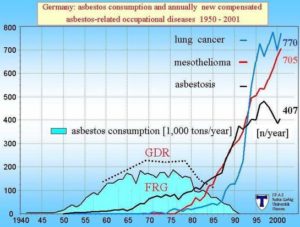
Fig. 3.1 Annual asbestos consumption and annual incidence of disease in Germany (Source: Woitowitz (2003)
http://www.hvbg.de/e/asbest/konfrep/konfrep/repbeitr/woitowitz_en.pdf
In the UK, there were around 1900 deaths from mesothelioma in 2001, 2002 and 2003, and the incidence of mesothelioma is expected to peak between 2011 and 2015 at between 2000 and 2400 deaths per year.
http://www.hse.gov.uk/statistics/tables/meso01.htm
It is estimated that lung cancer deaths from asbestos exposure are about twice as high as mesothelioma deaths. Thus, the total annual number of deaths from asbestos-related cancer in the UK alone is currently estimated to be around 5,500 to 6,000.
In countries where awareness of the dangers of asbestos is not yet as high, cancer diagnoses and statistics (especially for mesothelioma, which is difficult to diagnose) may be less reliable.
These diseases generally develop over longer periods of time and usually do not occur earlier than 10-60 years after the first exposure to asbestos. The average latency period from first exposure is about 35 to 40 years for mesothelioma. The average latency period for lung cancer has been estimated to be about 20-40 years. There is no direct experience of adverse effects from the inhalation of asbestos fibres.
Asbestosis usually develops following years of heavy exposure to asbestos, and the disease usually occurs more than a decade after the initial exposure. The cases of asbestosis that continue to be reported in Western Europe were almost certainly caused by heavy exposure several decades ago.
The risk of developing asbestos-related lung cancer and mesothelioma increases with exposure. The risk of disease is lower if exposure to asbestos is kept as low as possible. However, there is no known threshold below which there is absolutely no risk of developing these cancers. It is therefore important to use best practice to eliminate or minimise the risk of exposure.
It is thought that the risk of developing mesothelioma is greater for people exposed to asbestos fibres at a young age than for those exposed later in life.
It is generally accepted that lung cancer is much more common in smokers than in non-smokers. The risk of developing lung cancer from asbestos exposure is also higher in smokers than in non-smokers.
If you employ people who may be exposed to asbestos in the course of their work, you must. :
- follow best practice (as defined in this guide);
- ensure that people have received appropriate training and have been informed of the risks
- ensure that communication is effective (e.g. not hampered by communication difficulties);
- ensure that people understand the importance of minimising exposure;
- provide information on the increased risks due to the combination of smoking and asbestos exposure in order to encourage smokers to stop smoking;
- comply with legislation relating to work where exposure to asbestos is possible.
If you are likely to be exposed to asbestos in your work, you should. :
- Be aware of the risks associated with asbestos exposure;
- understand that it is important to minimise exposure;
- consider quitting smoking ;
- Follow best practice for working with asbestos, as outlined in this guide.
If you are a labour inspector, you must :
- Determine whether information (posters, brochures, etc.) on the health risks of asbestos exposure is available;
- check whether workers have been properly informed about the increased risk for smokers exposed to asbestos, for example by looking for leaflets or posters and interviewing the persons concerned;
- check that the relevant legislation has been complied with.
4.1 INTRODUCTION
Asbestos was widely used in many applications, e.g. for reinforcement or as thermal, electrical or acoustic insulation material. It has been used in friction products, gaskets and adhesives. Its chemical resistance has led to its use in certain processes, e.g. filtration or electrolytic processes. It has been used in commercial and industrial buildings as well as in private homes, as shown in Figure 4.1. It is also found in insulation materials for railway carriages, ships and other vehicles, including aircraft and some military vehicles.
The extent to which a material releases asbestos fibres depends on whether the material is intact or damaged. The condition of asbestos-containing materials can change over time, for example due to damage, wear and tear or ageing.
There are significant differences in the fragility of different materials and the ease with which fibres can be released. Table 4.1 summarises examples of asbestos-containing materials and their typical uses. Asbestos-containing materials are listed according to their potential to release asbestos fibres. Materials that are likely to release asbestos fibres easily are at the top of the list. Some asbestos-containing materials (bituminous mixes and rubber or plastic flooring) are flammable. These flammable materials should not be disposed of by burning as this would release asbestos fibres.
Table 4.1 Examples of asbestos-containing materials with indication of asbestos content
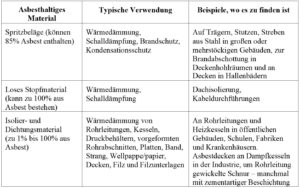
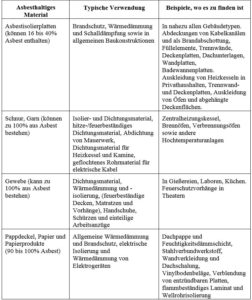
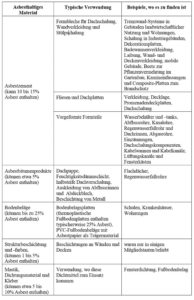

The extent to which different types of asbestos-containing materials were used varies considerably between Member States. In some, asbestos was mainly used as asbestos cement. In other Member States (e.g. the United Kingdom), the use of structural cladding (a cladding only a few millimetres thick, containing about 5 % of asbestos) has been popular only at times.
Table 4.2 summarises examples of the use of some of these asbestos-containing materials in household appliances and industrial applications.
Table 4.2 Examples of asbestos-containing materials and products used in household appliances and other applications
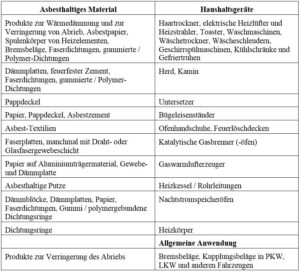
Products containing asbestos were manufactured by different manufacturers and offered under different trade names. In many cases, products that contained asbestos in the past were subsequently manufactured without asbestos. An exhaustive list of details of trade names, manufacturers and periods when the manufactured product contained asbestos is available for products sold in France on the INRS website (INRS ED1475,
http://www.inrs.fr/inrs-pub/inrs01.nsf/B20B5BF9E88608EDC1256CD900519F98/$File/ed14 75.pdf ).
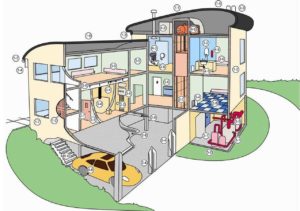
Fig. 4.1 The asbestos building shows the typical places where asbestos-containing materials can be found.
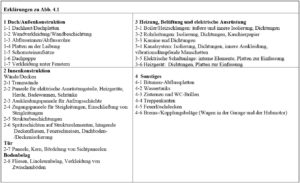
4.2 WHAT NEEDS TO BE DONE
There is a possibility of exposure to asbestos when carrying out general maintenance or repair work in buildings. If you are involved in such work in these areas, the advice provided here will be relevant to you:
If you employ or supervise people who may be exposed to asbestos-containing materials in the course of their work (see materials described above), you should :
- provide adequate training so that they recognise materials likely to contain asbestos and know what to do and when to do it if they come into contact with materials likely to contain asbestos;
- obtain reliable and good quality information on the presence or absence of asbestos-containing materials, for example from building plans and/or architects (in some Member States, the responsible person must draw up a list of asbestos-containing materials in a building);
- ensure that records are kept (e.g. by your organisation or the building owner) of materials that are proven to be asbestos-free;
- provide written information on the presence of known asbestos-containing materials on the site, including an asbestos inventory and, where appropriate, appropriate warning signs;
- provide written instructions on the procedures to be followed if asbestos-containing materials are unexpectedly encountered (in accordance with the information provided in chapters 9 and 10).
If your work is likely to release asbestos dust from a material listed above, you must. :
- have received information before the start of the work as to whether or not these building materials contain asbestos;
- know how to recognise products likely to contain asbestos;
- know what to do if you come across asbestos-containing materials (see Chapters 5 to 10).
If you are a labour inspector, you must :
- check that workers carrying out maintenance work have been adequately trained to recognise materials that may contain asbestos;
- check that adequate information is available on the materials that do or do not contain asbestos;
- check that organisational arrangements are in place to ensure laboratory analysis of samples of materials likely to contain asbestos;
- check whether there is a responsible person who can order the immediate interruption of work if materials likely to contain asbestos are discovered;
- check that the relevant national legislation is complied with.
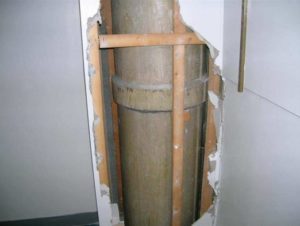
Fig. 4.2 Enclosure with asbestos insulation board (partially removed to show the asbestos cement flue behind).

Fig. 4.3 Asbestos insulation board as a partition wall. This example shows the practical problems of constructing a suitable joint and the areas where asbestos dust can accumulate during removal.
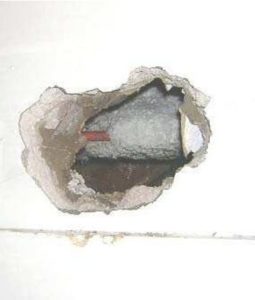
Fig. 4.4 Hole in wall reveals asbestos pipe insulation

Fig. 4.5 An asbestos cement flue sealed with an asbestos bead passes through an asbestos filler.

Fig. 4.6 Asbestos-containing floor tiles

Fig. 4.7 Asbestos-containing roofing felt
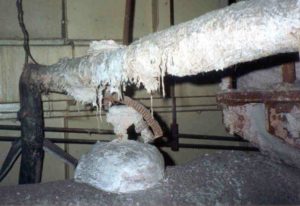
Fig. 4.8 Asbestos insulation of steam pipes
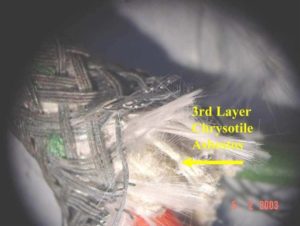
Fig. 4.9 Cables insulated with a layer of asbestos in the insulation
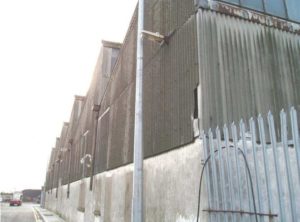
Fig. 4.10 Asbestos cement lining in a factory
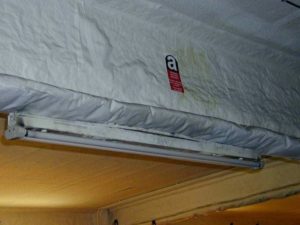
Fig. 4.11 Asbestos insulation on steel beams
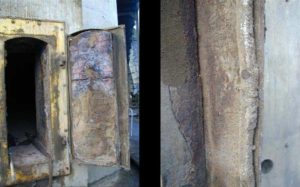
Fig. 4.12 Closing a chimney door with an asbestos cord. On the right, a close-up of the asbestos cord.
5 RISK ASSESSMENT AND WORK PLAN BEFORE CARRYING OUT THE WORK
5.1 INTRODUCTION
When preparing a risk assessment and work plan, it is good practice to document the assessment and the information used for it in writing.
In order to obtain information on the location of asbestos, an investigation by competent professionals may be necessary. The procedures for carrying out such surveys are not covered in this guide, but it is important that the responsible person (employer, manager, worker) is aware that they are required. The information should be provided in a form that is easy to understand.
Where information is provided, it is important to respect the limitations indicated in the information. For example, not all wall cavities may have been tested during an inspection.
In some Member States, there may be a policy of removing asbestos (especially weakly bound asbestos) where possible. In this case, the discovery of the presence of asbestos may trigger the need to comply with legislation requiring safe removal.
In other Member States, the decision on what to do with the asbestos-containing material is based on a review of factors relating to the risk of asbestos fibres being released from the material. This decision-making process is described in Section 6.2. Subject to this decision, asbestos-containing material may remain where it is and be treated as a non-hazardous hazard, provided that the material is well maintained, well sealed, documented (e.g. on building plans) and appropriately labelled.
Asbestos that is not removed must be regularly inspected to ensure that the material remains in good condition. In addition, it must be stated that the organisation and control of the proximity work is effective. If the asbestos is not in good condition or cannot be maintained in a safe condition, removal must be arranged.
If it has been decided to carry out work in areas where asbestos-containing materials are encountered or asbestos dust is released, a written assessment of the hazard and associated risks should be prepared. The risk assessment should be site specific, i.e. include the specifics of the site, and should include an assessment of potential exposures and a summary of available experience in controlling exposure to asbestos in similar circumstances. The risk assessment should take into account the risks of exposure to asbestos for workers as well as for other relevant persons in the vicinity (e.g. residents). This may be based on measurements from similar or previous work. Typical exposure concentrations measured by the UK Health and Safety Executive for work involving asbestos coatings, plasters and insulation boards are given in Appendix 1.
Written instructions (sometimes called a 'written work plan') should be prepared for each task.
The conditions under which work with asbestos is carried out create some practical difficulties with regard to emergencies, such as sudden incapacitating illness or injury. Access may be limited (especially if the work is carried out in an enclosure, see Chapter 12) and the wearing of breathing apparatus impedes communication. Emergency procedures should cover accidents and illnesses within an enclosure. This requires the following information:
- Number and names of rescuers
- Identification of first responders (if all persons are wearing protective clothing and full face respiratory equipment).
- the organisation of communication between people inside and outside the enclosure (especially in case of emergency)
- quick emergency access points to a compound, and when and how to use them
- Access procedures for emergency personnel
- the location of exits and emergency equipment
- Detailed decontamination procedures to be followed after an emergency access (e.g. access to assist an injured and immobilised worker in the enclosure).
The emergency procedures should also specify the measures to be taken in the event of an emergency evacuation of the building or site (for example, after a fire or bomb threat) by workers wearing personal protective equipment which may be contaminated by asbestos.
Risk assessments and written instructions (work plan) should be freely available on the construction site. They should take account of foreseeable emergency situations and indicate the procedures to be followed and the persons responsible in such an event.
5.2 WHAT YOU MUST DO
If you employ or supervise people who may release asbestos dust in the course of their work, you must :
- have prepared a written risk assessment and a written work plan for each task;
- ensure that the risk assessment takes into account the characteristics of the particular workplace and activities and includes a sufficient basis for estimating potential exposure;
- ensure that the risk assessment takes into account the exposure of all persons involved (e.g. machine operators, local residents, contractors' employees, etc.)
- ensure that the plan is detailed and relevant to the specific site and the work being carried out there;
Include preparatory work in the plan (e.g., erecting an enclosure); - Include in the plan a clear diagram of the site showing the location of equipment (e.g. containment, airlock, decontamination unit, negative pressure units, waste passage, secure contaminant container);
- consult workers with practical knowledge to ensure that the risk assessment and work plan are realistic;
- ensure that copies of the risk assessment and work plan are available on site and available to those involved in the work;
- Ensure that the risk assessment and work plan are explained to staff and those involved in the work;
- ensure that copies of the risk assessment and work plan have been sent to the supervisory authorities if required by national legislation;
- Include procedures for dealing with emergencies (including those described in section 5.1).
If you are about to carry out work that may release asbestos dust, you should
- Be consulted on the risk assessment and work plan;
- offer your suggestions on practical issues affecting the work plan and risk assessment;
- have a copy of the risk assessment and the work plan ;
- Make sure you have the work surface available.
If you are a labour inspector, you should check whether :
- an adequate and appropriate risk assessment is available on the construction site with regard to the exposure of workers and other persons;
- written instructions (work plan) with site-specific details are available on the website;
there is a contingency plan (e.g. as part of the work plan); - workers have an adequate understanding of the risk assessment and the work plan;
- the risk assessment and work plan show that workers' comments have been taken into account.
5.3 SAMPLE CHECKLIST FOR A WORK PLAN
The national regulatory body can provide guidance on the design of work plans (e.g. the "Method Statement Checklist" published by the UK HSE's asbestos licensing unit http://www.hse.gov.uk/aboutus/meetings/alg/policy/02-03.pdf ). A work plan may contain cross-references to general information on working methods, which should be included. The work plan should always be complete and describe all the specific characteristics of the site and the task (e.g. the site layout and any deviations from generally accepted methods).
The following checklist for a work plan is based on the advice of INRS, 1998 ED 815, Annex 6 and the UK Health and Safety Executive's Method statement.
This example is a non-exhaustive list of elements that the work plan should include or take into account. It should also include items relating to notifiable work (see Chapter 12). For low risk work (see Chapter 11), the work plan may be less comprehensive but should include the sections or items marked with an asterisk (*).
*Title page
Under the logo of the organisation carrying out the work:
- Date of issue
- General project title (asbestos removal, encapsulation)
- type of asbestos-containing material
- national licences or permits to carry out the work (if required by national legislation), date and duration of the work
- the name of the person responsible for the work and the name of the client
- the exact address of the site address
- name of the doctor (in EU Member States where a doctor is involved in occupational health and safety)
expected date of arrival of the executing company at the construction site
Administrative information
- Auftragnehmer oder Organisation, die die Arbeiten an den asbesthaltigen Materialien durchführt (Name des Direktors, Vertreter auf der Baustelle; mit Adressen, Telefon- und Faxnummern)
- Personen, die für die Arbeiten verantwortlich sind (Telefon- und Faxnummern)
- Name des ernannten, auf der Baustelle anwesenden Beraters
- the responsible laboratory for the delivery of messages on the premises (address, telephone and fax number)
- Unterauftragnehmer, insbesondere für Vorbereitungsarbeiten
- List of official organisations
* Information on the construction site
- * Location (e.g. shop in a shopping centre)
- * Type of work
- Planned treatment, removal and/or encapsulation
- Type of asbestos (crocidolite, chrysotile)
- Type and condition of asbestos-containing materials, quantity and distribution on the construction site.
- * Work programme, including date and time of work
- Staff
- Daily routine programme
- Designated areas
- Markings (type of signs, number, locations)
- The contaminant removal pathway
- Location of the decontamination unit
- Sanitary facilities and recreation rooms
- Site-specific factors (proximity to other activities, working in high temperatures, air conditioning or heating systems, working at height).
Factors affecting the removal or encapsulation plan
- Analysis of risks related to asbestos and other factors related either to the workplace (e.g. electricity, gas, steam, fire, machinery, working at height) or to the materials and equipment used.
- Measurement of fibre (or asbestos fibre) concentrations prior to intervention
- Likely exposure to asbestos during removal or encapsulation
Setting up the work (enclosure, etc.) on the construction site
- Staff facilities (drinks, sanitary facilities).
- Separation and marking of the area
- Impact on other activities in the building or surrounding area
Preparatory work
- Removal of equipment and materials
- Setting up a supply and disposal network (electricity, water, ventilation)
- Setting up the building systems in the work area (fire alarm, electricity, gas, central heating, air conditioning, etc.)
- Materials and equipment needed for the work
Preparation of the area where the asbestos work will take place
- Separation and closure (see Chapter 12)
- Generation of negative pressure
- Pre-cleaning of the work area and installation objects, removal or covering of installation objects.
- Closing off the area (safe working practices, materials and emergency exits)
- Negative pressure and air extraction
- Smoke tests, processes and acceptance criteria
Asbestos removal or encapsulation
- Methods (injection, spraying, manual scraping, etc.), equipment (injection equipment, spray equipment) and materials (wetting agents, cleaning agents).
- Worker protection (respirator)
- Quality control procedures (working methods and treatment efficiency)
Monitoring programmes (surveillance and measures)
- Sampling plan for the work period (see chapter 16).
- Systems for monitoring and controlling the effectiveness of containment.
- Plan of the locations where sampling is envisaged
Waste removal
- Status of waste (asbestos and non-asbestos containing materials), handling procedures.
- Waste disposal, safe storage on site and procedures for disposal in approved landfills.
Cleaning the work area
- Procedure for removal of surface materials and cleaning of surfaces
- Methods of decontamination of materials and equipment used in the work.
- Visual control and cleanliness check. System to maintain negative pressure. The designated person is responsible for the control systems.
Description and characteristics of materials and equipment used in the work
- Sampling for asbestos dust in indoor air, sampling plan, laboratory handling of the work
- Finally, the removal of the equipment from the
Description and characteristics of materials and equipment used in the work
- Staff equipment (including type of respirator).
- Decontamination unit (and documentation of test methods confirming that it is not contaminated from previous operations)
- Enclosure and associated equipment
- Enclosure size
- Negative pressure units (number and capacity, air change rate)
- Air lock, bag lock
- Water heater, water filter
- Lighting
- Injection equipment and other dust collection equipment
- Emergency equipment
- Consumables (filters, etc.).
Emergency measures
- First aid, emergency measures for situations with different degrees of urgency and danger.
- Procedures used for assistance in emergency pens
- Communication (to call for help from inside the enclosure)
- Coordination with external emergency services
Plans and drawings of the construction site
- Location of the construction site/enclosure in relation to other activities and businesses.
- The enclosure, its size and shape and the location of :
- Display panels and control television (if required)
- Negative pressure units and associated air change points
- Industrial class hoovers (for asbestos)
- Bag lock, waste passage, safe storage of waste (e.g. skip)
- Location of the decontamination unit, passageways (if there is no direct connection between the decontamination unit and the enclosure) and access to the enclosure airlock.
- Location of networks and equipment involved in the work (e.g. air intake points, water and electricity supply to the decontamination unit).
- Positioning of connection points if a network of compressed air supply connection points is used to supply the respiratory protective equipment.
6 ENTSCHEIDUNGSPROZESS
6.1 NOTWENDIGE ENTSCHEIDUNGEN
Dieses Kapitel beschreibt den logischen Entscheidungsfindungsprozess, wenn es darum geht:
- festzustellen, ob es besser ist, die asbesthaltigen Materialien an Ort und Stelle zu lassen (sie dabei ausreichend zu sichern sowie angemessen zu kontrollieren und managen) oder das Asbest zu entfernen
- zu entscheiden, ob bestimmte Instandhaltungsarbeiten so ausgeführt werden können, dass nur eine geringe Gefährdung durch Asbestexposition besteht und sie als Arbeiten mit "gelegentlicher Exposition von geringer Höhe" eingestuft werden können, die ohne vorherige Meldung an die zuständige Behörde ausgeführt werden können.
6.2 ANLEITUNG ZU ENTSCHEIDUNGEN ÜBER ASBESTHALTIGE MATERIALIEN IN GEBÄUDEN
There are a number of key decisions that need to be made before carrying out work in which asbestos-containing materials may be involved. These decisions are closely linked to the risk assessment and planning process (Chapter 5). The hazard assessments will determine the appropriate decisions; these decisions will affect the purpose and content of the plans to be prepared.
There are a number of factors to consider when deciding what work to carry out. In some EU Member States, there is national legislation which in principle requires the removal of asbestos-containing materials (especially materials containing weakly bound fibres) where this is practicable. Other Member States decide whether asbestos-containing materials can be left in place depending on certain criteria, such as condition, location, access and thus the overall likelihood that the material presents a risk of releasing fine asbestos fibres. National legislation must therefore be taken into account when deciding whether materials should be secured (e.g. by encapsulation and/or containment) and can be left in place.
Subject to national legislation, asbestos-containing materials that are in a safe condition (i.e. undamaged, sealed or encapsulated) may be left in place provided that effective control and management of the safe materials is provided. If asbestos-containing materials are left in place, they should be identified in the building records and plans so that their presence can be taken into account in future works. In addition, a system should be in place to monitor asbestos-containing materials and manage their condition (e.g. maintain materials in good repair).
Figures 6.1 and 6.2 show logical decision trees. The starting point is to identify whether a material is asbestos or not. Then a system is used to decide whether the material should be removed or not. Once it is known that the material contains asbestos, a series of questions follows to find out whether the material contains asbestos.
- is in good condition; or
- is difficult to repair
- accessible (in which case it may be damaged accidentally or intentionally; if it is not accessible, its removal may be impeded and limited)
- damaged, with more than minor and superficial damage (such that repair would be unreliable)
- extensive damage (i.e. damage so extensive that encapsulation of the damaged parts is no longer possible)
cannot be encapsulated or enclosed (for reasons other than those mentioned)
If the asbestos-containing material is not in good condition, if it cannot be easily repaired, if it is easily accessible (and therefore potentially subject to further damage or disturbance), if it is badly damaged and if there is no practical way of encapsulating or containing the material, then the material must be removed. This decision applies to any type of asbestos-containing material.
The alternative to removing asbestos-containing materials is to make the materials safe (by keeping them in good condition or enclosing them) and to monitor and manage them in situ.
Although asbestos-containing materials can be made safe and monitored and managed in situ, it is necessary to take into account the potential requirements of normal renovation work in the building. If the materials interfere with normal renovation work in the building, removal of the asbestos-containing materials would be the right decision.
For asbestos cement and other materials with closely related fibres, the decision-making process would probably lead to a decision to leave the material in place, document it, monitor it and manage it.
Fig. 6.1 Decision tree for suspected asbestos materials
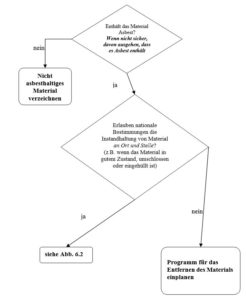
6.3 DECISIONS ON THE OBLIGATION TO REPORT WORK
The risk assessment is the basis for deciding whether the work should be treated as notifiable asbestos work.
Directive 2003/18/EC (Protection of workers from the risks related to exposure to asbestos at work), which supplements Directive 83/477/EEC, applies to all workers who may be exposed to dust from materials containing asbestos.
EU Directive 2003/18/EC requires that work be reported (to the supervisory authority of the EU Member State concerned) and that health surveillance of workers be carried out and documented. It also requires employers to keep a register of workers "indicating the nature and duration of their activities and the hazards to which they have been exposed". In certain clearly defined cases, these provisions need not apply. "Provided that the exposure is occasional and low level and that the results of the risk assessment clearly show that the exposure limit value for asbestos in the air in the work area is not exceeded, [the above provisions] need not be applied to the following operations
- short, non-consecutive maintenance operations, working only on non-friable materials.
- Removal of intact materials in which the asbestos fibres are firmly bound in a matrix, leaving the materials intact.
- Encapsulation and packaging of asbestos-containing materials in good condition
- Air monitoring and control and sampling for asbestos in a particular location".
Figure 6.3 shows a procedure for determining whether a job meets the criteria for non-application of the legislation.
The Directive (2003/18/EC) sets the exposure limit for asbestos at 0.1 fibres/cm3, (8-hour weighted average). Some EU Member States determine the hourly average over shorter periods (4 hours or 1 hour).
The national regulations of the Member States may differ as to whether and to what extent use is made of the possibility to derogate from these provisions.
Therefore, all work with friable materials (e.g. sprayed coatings, coatings, loose tamping materials) should be treated as notifiable work and also require medical surveillance. In the case of other materials, the condition must be assessed and a risk assessment carried out in order to obtain the information necessary to make a decision on a possible exemption from the reporting obligation.
For work involving the handling of fixed fibre materials, e.g. asbestos cement, the risk assessment should take account of the nature and duration of the work. Annex 1 gives examples of air concentrations that have been reported as typical for various activities involving asbestos cement.
If you employ or supervise people who may be exposed to asbestos dust in the course of their work, you must
- Carry out a risk assessment for the work in question;
- Use the decision-making process to determine the appropriate course of action (i.e. whether the material can be removed or secured and left in place and managed, and whether the work should be reported);
- Establish and maintain a written record of the type of material (e.g. sprayed-on cladding or insulation board or asbestos cement) and its condition (e.g. comment on the nature and position of the damage, using photographs if possible);
- Prepare a record of the documents used in the risk assessment to estimate the possible concentration in air;
record the decision process (e.g. answers to questions in corresponding logical decision trees); - Plan the work and organise indoor air measurements, unless there is clear evidence of air concentrations likely to be encountered.
If asbestos-containing materials are likely to be damaged during your work, you must. :
- be involved in the risk assessment that contributes to the above decision-making process.
If you are a supervisor inspecting a construction site where asbestos-containing materials are present, you must :
- examine the evidence that the decision not to remove the material was justified;
- check that the condition of the materials which led to the work being considered non-notifiable in the risk assessment actually meets the criteria described in 6.3 (e.g. non-friable, non-degraded, in good condition);
- ensure that the monitoring and management of materials left behind is carried out;
- check that the information used to estimate likely exposures is adequate, particularly if the risk assessment indicates a low level of exposure.
Fig. 6.3 Decision tree for deciding whether the work is notifiable or not
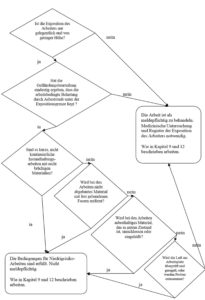
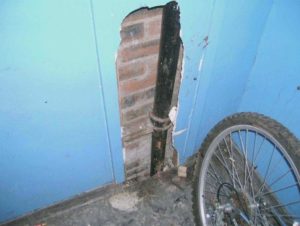
Fig. 6.4 Asbestos containing insulation board. Removal of the board should be considered as the board can easily be damaged at this stage.
7 INSTRUCTION AND INFORMATION
7.1 INTRODUCTION
This chapter outlines the topics to be covered in a training programme and refers to other publications for further details. In particular, the report by Bard et al (2001), which provides detailed recommendations on the structure and content of an asbestos training programme, provides detailed information for training providers. The European Directive (2003/18/EC) states that "Employers shall provide appropriate training to all workers who are or may be exposed to dust containing asbestos. This training must be provided at regular intervals and must be free of charge for workers. 2. The content of the training must be easily understood by the workers. The instruction must enable workers to acquire the knowledge and skills necessary for prevention and safety...".
The recommendations of a SLIC working group are described at: http://www.ilo.org/public/english/protection/safework/labinsp/asbestos_conf/inforen.pdf. The UK training recommendations are described at: http://www.hse.gov.uk/aboutus/meetings/alg/licence/04-04.pdf.
The training should be presented in a way that is easily understood by the participants (employer, supervisor or worker) and include practical exercises on the use of all equipment. It should be delivered in the language that the workers (especially workers of other nationalities) know and understand.
This chapter also includes brief indications on the required training programme (initial training, refresher courses, regular review of training needs, etc.).
This chapter aims to make it clear to the employer what training he should organise for workers, supervisors and himself. The worker should know what training he is entitled to. This information also serves to provide the labour inspector with a clearly described framework for checking the adequacy and effectiveness of the training.
7.2 TRAINING CONTENT
7.2.1 Essential training content for all asbestos-related work
Training for all persons (employer, supervisor, worker) involved in work where they may (possibly) be exposed to asbestos-containing materials should include the following topics
- the properties of asbestos and its effects on health, including the synergistic effect of smoking
- the different types of materials and products likely to contain asbestos and where they are likely to be found
- the importance of the condition of the material or products for the possibility of asbestos fibre release
- the necessary measures to be taken when materials likely to contain asbestos are encountered
7.2.2 Core training content for general construction
Workers, employers and supervisors who may be exposed to asbestos in the workplace shall receive appropriate training. This training should cover the following elements, in addition to the content listed in section 7.2.1:
- the type and extent of information that should be available where asbestos-containing materials are located (e.g. some EU Member States require inventories on the presence and location of asbestos-containing materials in buildings)
- the obligation to stop work immediately if materials suspected of containing asbestos are encountered and to inform the responsible supervisor
- the measures required to reduce potential exposure if the suspected asbestos material is in poor condition or accidentally damaged (e.g. evacuation of the immediate area, necessary safety measures and informing the responsible supervisor)
- for the supervisor and the employer as recipients: analytical testing of samples in the laboratory to confirm the presence or absence of asbestos.
Training should also cover emergency situations where asbestos is suspected to be present in a material after it has been damaged. In such cases, training should include procedures to ensure that the situation is not exacerbated by inappropriate actions (e.g. attempting to sweep up the material) or by inaction that perpetuates asbestos exposure.
7.2.3 Essential training content for low risk asbestos work
If the training is intended for workers carrying out low-risk work, i.e. work meeting the criteria set out in point 6.3, it must cover the content specified in point 7.2.1 and above:
- Activities that may lead to exposure to asbestos.
- The importance of effective control measures to prevent or minimise exposure to asbestos dust and to prevent the spread of asbestos contamination
- safe work practices that minimise exposure, including control techniques, personal protective equipment, risk assessments and written instructions (work plan)
- The importance of respiratory protective equipment, selection of the appropriate respirator and its correct use
- Proper care and maintenance of personal protective equipment and respiratory protective equipment
- Decontamination procedures for people
- Procedures for the following emergency situations, e.g. accidental damage to asbestos-containing materials or injury or illness to persons while carrying out work on asbestos
- Disposal of the waste, appropriate encapsulation (e.g. bagging or wrapping) of the waste to prevent the spread of contamination, labelling and maintenance of a secure skip or container at the point of transport by a licensed asbestos waste disposal contractor to an approved (or licensed) landfill.
For workers and supervisors, training should include practical exercises to familiarise them with sample materials and to practise the correct use and maintenance of equipment and proper work techniques.
Training for supervisors and employers should also cover legal responsibilities and work supervision.
7.2.4 Essential training content for asbestos removal work
If the training is for workers doing notifiable work (i.e. the hazard being assessed does not meet the criteria for low-risk, limited-scope work set out in Section 6.3), then more comprehensive training is required. This should cover the topics listed in section 7.2.3, but also the nature of the work and the topics relating to the notifiable work.
The training of asbestos removal workers should include practical exercises to learn how to use and maintain safety-related equipment (enclosures, personal protective equipment, respiratory protective equipment, decontamination units, dust removal equipment and equipment for the controlled removal of asbestos-containing materials).
The topics listed in sections 7.2.1 and 7.2.3 are expanded to include the following:
- When discussing the health effects of asbestos, the relationship between exposure and risk of disease should be emphasised in order to highlight the importance of preventing or minimising exposure to asbestos.
- When discussing products that may contain asbestos, detail the characteristics of the products that should be considered when removing them.
- The discussion on safe working practices should also address the following points:
- Good work planning, including good site design (positioning of equipment, e.g. airlocks, decontamination unit, shortest and safest route for transporting waste to a safe skip).
- An appropriate and sufficient risk assessment covering all aspects of the work, and a detailed work plan.
- Site preparation prior to erecting an enclosure/barrier, including any pre-cleaning that may be required.
- Procedures for erecting a partition, extra protection of the floor and any weak points. Ensure that all parts of the wall can be cleaned properly, i.e. there should be no place where dust/dirt can settle. Exhaust airlocks, ventilation airlocks, vision panels (and control TV if required), negative pressure units, including easy to change pre-filters, power supply cables from outside the enclosure so that fuses can be changed, etc.
- Maintenance of an enclosure (ventilation efficiency - negative pressure unit, enclosure integrity, periodic inspections, etc.), including the importance of smoke testing before work begins.
- Techniques for removing asbestos with minimum dust generation, including dust suppression methods such as 'wet stripping', rapid bagging of materials to prevent the spread of dust (onto feet, equipment or clothing) and, for supervisory personnel, monitoring the effectiveness of the operation.
- Cleaning of the enclosure, airlocks and sanitary facilities; complete cleaning (from top to bottom).
- Effective communication (including between people inside and outside the venue).
- Re-cleaning if an enclosure is not released
- Enclosure cleaning and dismantling procedures
- When discussing respiratory protective equipment, the following points should also be addressed:
- Positive pressure ventilation and/or compressed air hood
- Cleaning/maintenance of respiratory protective equipment
- The importance of checking the fit of equipment and the factors that influence it; examination, testing, cleaning and maintenance of respiratory protective equipment.
- The different types of respiratory protective equipment, their advantages and limitations
- Emergency measures to be taken in the event of a power failure (electricity or compressed air) in a work situation
- Possible limitations (e.g. visibility) and difficulties in using respiratory protective equipment.
- Training in emergency procedures would cover procedures to be followed in the following situations:
- Emergency measures for people who are injured or become ill in an asbestos-contaminated area.
- Emergency evacuation (e.g. in case of fire)
- Power or equipment failure (negative pressure, breathing apparatus)
- Leakage outside the enclosure
- Interruption of the water supply to the sanitary unit
- Training in personal decontamination procedures would include the following:
- the use of airlocks, entrance/exit to the enclosure and decontamination unit, which may be either directly connected to the enclosure or separate from it
- Change of personal protective equipment, showers, disposal of suits.
- Maintenance of a decontamination unit
- Decontamination of people in the event of an accident or evacuation
- Correct use and maintenance of equipment used for asbestos removal
- Other potential hazards, for example asbestos removal at high temperatures, working at great heights, setting up and using access equipment at higher workplaces
- Waste disposal :
- Procedures for bagging and packaging waste
- Safe containment (e.g. packaging and/or bagging)
- Marking
- Safe passage through the bag closure and defined path from containment to safe storage site.
- Transport of the waste from the remediation site to an approved landfill by an approved asbestos waste disposal contractor.
- Evidence of waste traceability from the construction site to the landfill (e.g. roadmap).
For workers who are required by the Directive to undergo medical examinations, the training must include the following elements
- The requirements of the health check, including its purpose and importance (as described in Chapter 19) and the need for documentation that it has taken place.
- Information and advice that can be given to workers following a medical examination.
For supervisors and employers, training should also include the following elements
- Good planning
- Inspection and testing of equipment (e.g. decontamination unit, enclosure, dust suppression equipment);
- How to detect defects.
- Inspection of the work during its execution
- Check the effectiveness of fibre concentration control
- Audit of skills and training needs
- Keeping records
- Need for intensive training of new workers
In addition to practical supervision, training for supervisors and employers should address the topics covered in Chapters 5 and 6, namely
- Preparation of a risk assessment (with regard to exposure of workers and others) and a work plan
- relevant laws and regulations
- their functions and responsibilities
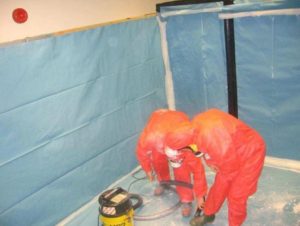
Fig. 7.1 Practical exercise in using a Type H hoover to remove a simulated contaminated material (talc). This illustration was provided by the UK HSE.
7.3 TRAINING PROGRAMME - YOUR TASK
If you employ or supervise people who may be exposed to asbestos in the course of their work, you must. :
- provide appropriate initial training, as described above, before they undertake the work;
- assess whether refresher training is required - this should be provided at least annually and when procedures or the nature of the work changes - and keep appropriate records;
- Organise regular task briefings (called 'toolbox talks'), especially if a particular task involves something unusual;
- Organise training by a competent provider (e.g. an organisation or individual with knowledge of appropriate procedures and good working practices and with the skills to deliver the training content);
- ensure that each trainee receives instructions in a language they understand;
- keep a record of the training successfully completed, which must be accessible to anyone in the workplace;
- Ensure adequate supervision in the workplace, with particular attention to newly qualified workers.
If your work involves a risk of exposure to asbestos, you must. :
- Receive appropriate training before undertaking the work;
- Have the need for retraining assessed regularly (at least once a year) and whenever there is a significant change in the nature of the work;
- inform your employer if there are any language problems that may affect your understanding of the training (for example, does your employer know what your first language is?)
If you are a labour inspector, you must :
- check that there is documentation of the training courses successfully completed by each worker on the site;
- check whether there is documentation of periodic assessments of the need for refresher training for each worker;
- check that foreign workers have received training in one or more languages they understand;
- check whether the training was provided by a competent training company/trainer.
7.4 INFORMATION
For all activities where workers are or may be exposed to dust from asbestos-containing materials, Directive 2003/18/EC (Protection of workers from the risks related to exposure to asbestos at work), which supplements Directive 83/477/EEC, requires that workers and their representatives be provided with adequate information on :
- health risks due to exposure to asbestos dust or materials containing asbestos
- legally binding limit values and the need to monitor asbestos dust emissions
- hygiene requirements, including the need to refrain from smoking
- precautions to be taken with regard to the wearing and use of protective equipment and clothing
- special precautions to minimise exposure to asbestos.
These points are included in the training programme recommended above. In addition, information on these issues should also be readily available in the workplace in an appropriate form (e.g. posters, notices or brochures).
8 EQUIPMENT
8.1 EQUIPMENT
Adequate equipment must be available for the job. The basic equipment for most tasks is listed in this section. Equipment should be kept in good condition and therefore maintained as described in Section 8.2.
8.1.1 FOR LOW-RISK WORK (NON-REPORTABLE)
For low risk asbestos work (which does not have to be declared), the equipment required includes the following:
- Equipment to isolate and separate the work area (tapes, barriers, markings, warning signs).
- Materials to prevent the spread of contamination (durable polyethylene sheets of 125 and 250 µm thickness [also known as 500 and 1000 thickness polyethylene sheets], wood, plastic or metal materials).
- Smoke test tubes to check the integrity of the small boxes.
- Personal protective equipment (e.g. disposable overalls, washable boots) and respiratory protective equipment (e.g. disposable asbestos respirators EN 149 type FFP3 or half-masks EN405 - with face fit test to determine suitability for each worker and regular replacement of contaminated filters).
- Type H hoover, i.e. a hoover equipped with HEPA (High Efficiency Particulate Air) filters manufactured according to international specifications for use with asbestos.
- Dust suppression equipment, e.g. local exhaust with connection to a Type H hoover to collect dust from boreholes, etc.
- Appropriate containers for asbestos waste (e.g. properly labelled plastic bags).
cleaning equipment and consumables (wet wipes, dust cloths, airless fine water spray)
safe storage of waste - hygiene facilities for personal decontamination (washing facilities, preferably a shower), with storage facilities for work and protective clothing separate from normal street clothes (see 8.1.2 for personal decontamination facilities required for reportable asbestos work)
- consumables for personal decontamination (shower gel, nail brushes, towels)
- Water filtration equipment
8.1.2 Additional equipment for reportable work
For notifiable work with asbestos, you must also have the following:
- a complete enclosure (durable polyethylene sheet, frame and negative pressure unit with pressure monitoring equipment; one EU Member State requires pressure monitoring equipment that continuously records readings).
- the enclosure should have its own observation windows or television surveillance to allow inspection of the structure and workers without having to enter the enclosure
- Good lighting (movable, cleanable lamps suitable for use in the enclosure).
- smoke generators to check the integrity of large enclosures
- high performance full-face respirators (with personnel who have completed face-fit tests for this type of respiratory equipment); or air-supplied respirators
- personal protective equipment (disposable suits and washable boots)
- A fully cleanable decontamination unit with an adjustable heated shower and separate areas for clean and discarded contaminated work clothes. There must be a certificate confirming that the decontamination unit has been tested and found to be uncontaminated prior to its arrival on site. There should be at least one shower (decontamination unit) for every four workers engaged in asbestos work.
- the filtration of waste water prevents the spread of asbestos.
- best practice (used in some EU Member States) is to use a five-chamber unit with two shower rooms (see section 12.4 for a diagram showing the layout and appropriate use of decontamination equipment). This five-chamber system is used when workers wear impervious coveralls that are cleaned in a shower. After removing the washable suit, which can be stored in the middle chamber, the worker uses the next shower chamber. A widely used and accepted alternative is a three-tiered unit consisting of a shower between a "clean end" and a "dirty end"; this system is suitable for workers wearing disposable suits.
- A High Efficiency Particulate Air (HEPA) exhaust filter provides airflow (through grilles) from the "clean end" to the "dirty end" of the decontamination unit. Self-closing doors separate the sections. During cold seasons, the clean end must be heated to provide a warm and comfortable environment for changing and showering.
- A negative pressure unit (exhaust fan with HEPA filter) to maintain ventilation inside the enclosures, with a control unit to monitor the pressure. Best practice (as defined in one EU Member State) is to use continuously recording monitoring devices (e.g. by recording the pressure difference on paper). One Member State requires the negative pressure unit to comply with a national quality standard (British Standards Institution; PAS 60 Part 2).
- For notifiable work (Chapter 12), in particular for the removal of materials containing only weakly bound asbestos, one EU Member State requires an emergency generator to supply ventilation
key electrical equipment (negative pressure ventilation, lighting, etc. in the enclosure) and water storage tanks sufficient to provide water for the recommended personal decontamination. (The equipment should only be used by competent and appropriately trained personnel).
- Dust suppression equipment for injecting water into asbestos-containing insulation prior to removal and for spraying the surfaces of asbestos-containing materials.
- Safe storage of asbestos waste
This list is not exhaustive, but it shows the amount of equipment needed to be protected against the risk of exposure to asbestos. Other equipment (such as fire extinguishers and first aid equipment) is also needed.

8.1.3 Selection of respiratory protective equipment
The EU Directive 2003/18/EC states that for activities (such as repair, maintenance, removal and demolition) which may generate asbestos concentrations above the permissible exposure limit value (for the value, see section 6.3), the employer must specify additional measures to protect workers, in particular that "workers shall be provided with appropriate respiratory protective equipment and other personal protective equipment to be worn". Therefore, appropriate respiratory protective equipment should be selected based on the risk assessment (Chapter 5). Guidance on the selection, use and maintenance of respiratory protective equipment is available in EN 529.
Selection should be based on the following principles:
- the concentration inside the mask should be kept as low as possible, but never exceed the exposure limit.
- the equipment must be suitable for the worker and the conditions in which he or she works
- the nature of the work, B. the range of motion required, and any barriers or restrictions
- The conditions on the site, e.g. the possibility of access and free movement in the work area
- The individual conditions of the head of the face
- Its medical fitness
- The conditions under which the wearer must use the equipment
- Wearing comfort, in relation to the conditions of the particular site, so that workers wear the equipment correctly for the required period of time
One EU Member State recommends that :
- The use of disposable respiratory protective equipment (EN FFP3) should be limited to situations where the concentration does NOT exceed 10 times the exposure limit and where exposure lasts for a relatively short period. The flexibility of the mask provides comfort, but it also causes mask deformation - particularly in demanding work - which in turn can lead to leakage when the mask and face are tightly fitted.
- A half mask with a P3 filter offers slightly more protection than a disposable respirator, as the half mask offers a more reliable seal to the face.
- Battery operated respirators (caps, coveralls) with a P3 filter are more suitable for longer or more difficult work.
- Full face masks (or suits) supplied with compressed air (also known as SCBA) should be used where concentrations may exceed 50 times the exposure limit.
Another EU Member State (the UK) provides tables of protection factors that can be used to select the most appropriate protective equipment for the situation, see Tables 8.1 and 8.2 below. The protection factors in the table also show that EN FFP3 disposable respirators are not suitable if the airborne concentration exceeds 20 times the exposure limit. A self-contained breathing apparatus (or an independent breathing apparatus) should be used when concentrations exceed 40 times the exposure limit.
The performance of masks (such as filter masks, full face masks and half masks) is highly dependent on maintaining a good seal between the user's skin and the mask. As the shape of the face varies greatly from person to person, one size or type of respirator may not be suitable for all faces. Therefore, it is important that :
- A face fit test is part of the procedure for selecting appropriate respiratory protective equipment.
- wearers of respiratory protective equipment should be involved in the selection process, as this ensures that the equipment chosen is suitable for them and that they will accept and use it correctly
Facial fit testing and wearer participation may be mandatory according to national legislation or guidelines.
Beards, sideburns or even visible beards affect the sealing effect of the face mask. Workers with these characteristics will need respiratory protective equipment that does not rely on a face seal (e.g. caps or actively ventilated suits).
Wearing conventional goggles also prevents a satisfactory seal. However, there are full-face masks that allow special frames to be attached to the inside of the mask.
EU Directive 2003/18/EC also states that where respiratory protective equipment is required to be worn, "it shall not be permanent but shall be limited to an absolute minimum time for each worker. During the period of activities requiring the wearing of personal respiratory protective equipment, rest breaks shall be provided in accordance with national laws and practices, depending on the physical and climatic exposure and, where appropriate, in consultation with the workers and/or their representatives.
Table 8.1 Types of respiratory protective equipment available for protection against asbestos dust
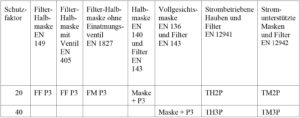
Table 8.2 Types of respirators available for protection against asbestos dust
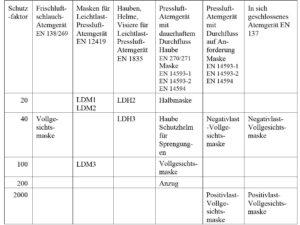
8.1.4 Correct use of respiratory protective equipment
The EU Directive 2003/18/EC stipulates that workers must be trained in the knowledge and skills related to "the purpose, range and selection, performance limits and correct use of respiratory protective equipment".
Respiratory protective equipment must be properly fitted and worn to ensure effective protection.
For disposable respirators, both head straps should be fastened behind the head and the nose clip should be pressed into position on the nose saddle.
For face masks, the straps should be tightened so that the equipment stays in place. The head harness should generally be worn under the cover of the suit.
Respiratory protection should never be removed in a contaminated environment, except in an emergency (e.g. medical emergency).
8.1.5 Maintenance of respiratory protective equipment
Respiratory protective equipment should be clean and in good condition before being handed over to the wearer.
Before using the respiratory protective equipment, the user should ensure that it is in good condition and usable, e.g.
- Condition of the headgear system, face piece, including seal and visor.
- Valve condition
- Condition of threaded connections and seals
- Status and type of filters; filters should not be past their expiry date.
- Airflow for compressed air and motorised equipment
- the completeness and correct fitting of respiratory protective equipment
- and that the tests or checks recommended by the manufacturer have been carried out
After use, masks should be cleaned and disinfected for the next use. The respirator shall be stored in a clean, designated area.
(See also section 8.3.2 on regular maintenance).
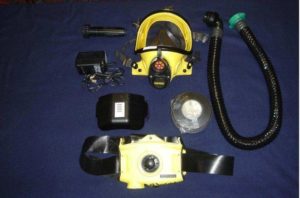
Fig. 8.2 Respiratory protective equipment. This figure was provided by the UK HSE.
8.2 MAINTENANCE OF THE EQUIPMENT
8.2.1 Inspection and maintenance
Regular inspections of equipment should be carried out and recorded by a competent and responsible person. The maintenance and inspection programme should include: the enclosure itself (at each station), H-vacuum(s), hygiene equipment/decontamination unit (at each station), dust suppression equipment (at each station).
Inspections should include the following checks: Condition of equipment (wear and tear), cleanliness and availability of supplies in the decontamination unit (soap, towels, new filters for respirators, etc.), adequate lighting (in airlocks and in the enclosure), provision of consumables for cleaning, operation of smoke generators and negative pressure unit (e.g. check whether the pre-filter needs to be changed).
It is important that respirators are properly and regularly maintained, inspected and serviced.
Air monitoring is part of the inspection and is described in Chapter 16.
All portable electrical equipment should be regularly inspected to ensure that cables and connections are not damaged and that electrical safety is assured. If portable electrical equipment is used in a wet environment, it should be suitable for use in such an environment.
8.2.2 Maintenance
All equipment should be regularly maintained to ensure that it is still fit for purpose.
Negative pressure units (for the containment and decontamination unit) should be regularly maintained by competent persons. After replacing the high-efficiency filter, the performance of the filter should be tested with a safe replacement aerosol (e.g. di-octyl phthalate [DOP]) by a person competent in this test.
Wastewater filters (from the decontamination unit and the enclosure) should be changed regularly. Used filters should be disposed of as asbestos-containing waste.
The components of respiratory protective equipment can wear out and thus impair the protective function. Therefore, respiratory protective equipment should be maintained regularly and this should be documented accordingly. National legislation may specify the length of time for which records must be kept and be available for inspection.
Type H hoovers should be serviced regularly.
8.3 YOUR TASK
If you employ or supervise people whose work involves handling the equipment described here for working with asbestos, you must ensure that :
- that adequate equipment is provided and that it is in good condition;
- the equipment is maintained in good condition, i.e. it is inspected, maintained and serviced regularly;
- Records are kept of inspections and maintenance;
- workers are trained in "the purpose, range and selection, performance limits and correct use of respiratory protective equipment";
- adequate supervision is in place to ensure the correct use of the equipment;
- protective equipment is properly maintained and used
If you intend to use the equipment described above when working with asbestos-containing materials, you should :
- Have been trained in the correct use of the equipment;
- Always use the equipment correctly (in accordance with the manufacturer's training and instructions);
- Have participated in the selection of respiratory protective equipment;
- have been face tested on the respiratory protective equipment provided to you and instructed in its correct use;
- Always wear respiratory protective equipment correctly and never remove it in areas potentially contaminated with asbestos.
If you are a labour inspector, you should check this:
- the equipment is in good working order, properly maintained and repaired, and that the necessary maintenance records are available;
- respiratory protective equipment is used correctly;
- a face fit test was performed for each worker for the type of respiratory protective equipment they use.
9 GENERAL PRINCIPLES FOR MINIMISING EXPOSURE
9.1 GENERAL CONSIDERATION
Before carrying out any work which may involve a risk of exposure to asbestos dust or dust from asbestos-containing materials, a risk assessment should be carried out (as described in Chapter 5) to determine the nature and extent of workers' exposure. The risk assessment is the basis for decisions on the necessary protective measures. The following three chapters deal with the protective measures required in the following situations:
- Work where asbestos may be found (e.g. maintenance work in buildings dating from a year of construction where some unlisted asbestos-containing materials may still be present, Chapter 10).
- work for which the level of exposure is so low that it does not have to be declared (as described at the beginning of Chapter 11)
- Reportable work (e.g. asbestos removal, Chapter 12)12)
However, exposure must be minimised in all cases and general procedural principles exist for all three situations:
- Determine the quantity and location of asbestos-containing materials.
- Restrict access to the work area accordingly (e.g. by means of tape, barriers or a complete enclosure).
- Provide clear and appropriate signage (e.g. Danger! Asbestos! Access by authorised personnel only!)
- Enclose or protect (e.g. with durable polythene sheeting) the area, depending on the extent of the work, to prevent contamination by asbestos dust (this is discussed later in this guide).
- Minimise the number of people allowed in.
- Use appropriate respiratory and personal protective equipment (e.g. disposable suits and washable boots).
- Use appropriate techniques to limit fibre release (e.g. wetting, wet stripping, local exhaust ventilation).
- Avoid damaging the asbestos-containing material (e.g. remove and dispose of whole pieces, remove and wrap up whole sheets).
- double bag or wrap and label (as asbestos) all materials that may contain asbestos prior to disposal.
- clean thoroughly (see Chapters 11 and 12)
- protect all transport routes to prevent the spread of asbestos contamination
- Ensure the encapsulation (e.g. packaging or bagging) and storage (e.g. in a lockable container) of all asbestos waste.
- Ensure safe transport to an approved waste disposal facility.
- dispose of asbestos-containing waste only in landfills authorised to accept asbestos (in accordance with national legislation)
- ensure compliance with the necessary control measures to prevent exposure.
As part of preventive measures against exposure to asbestos by inhalation or ingestion,
- areas where activities involving asbestos are carried out must be smoke-free areas
- areas should be created where workers can eat and drink without risk of asbestos dust contamination
9.2 YOUR TASK
Persons carrying out tasks related to asbestos work must be fit for such tasks. A person is considered fit if they have sufficient training, experience and knowledge in relation to the nature of the task to be performed. Factors to be taken into account are the complexity of the task and the risks that may arise if the task is performed incorrectly.
If you employ or supervise people whose work is likely to involve the handling of asbestos, you must :
- provide adequate training so that they can identify the scope of work they are competent to undertake (see Chapter 7);
- Provide equipment appropriate to the situation for the next stages of work;
- plan and ensure proper maintenance and inspection of this equipment;
- provide written instructions describing the procedures to be followed according to the circumstances on site.
If your work is likely to involve the handling of asbestos-containing materials, you must. :
- Know and understand the precautions to be taken and the consequences if the proper precautions are not taken;
- know what work can be done with your level of training and equipment;
- Follow the necessary control system to avoid exposure;
- be able to call in a specialist if the extent of work with asbestos-containing materials is greater than your work plan, equipment or training allows.
If you are a labour inspector, you must :
- Check that the appointees' training certificates show that they are trained to carry out the assigned work;
- Check which training certificates relate to which worker by looking at a photograph;
- ensure that appropriate equipment is provided, maintained and inspected regularly;
- ensure that appropriate supervision and monitoring is carried out.
10 PROFESSIONS THAT MAY INVOLVE EXPOSURE TO ASbestos
A number of occupations are likely to encounter unexpectedly and possibly damage asbestos-containing materials during work. These include: Carpenters, joiners, shopfitters, plumbers, gas supply technicians, electricians, computer wiring installers, caretakers and helpers. Demolition workers, ship wreckers and repairers, and vehicle technicians and others may also come into contact with asbestos.
Information on the presence of asbestos-containing materials should be made available to these companies before work begins so that they can make efforts to avoid the risks. However, they must be prepared to encounter asbestos-containing materials unexpectedly, as there is always a risk that information on asbestos cases may be incomplete, for whatever reason. Chapter 9 contains general procedures for work that may involve asbestos. This chapter gives detailed information on maintenance and servicing work that may involve asbestos. If asbestos-containing materials are discovered unexpectedly, the first priority is to stop the work immediately and prevent third parties from being exposed and spreading the asbestos contamination.
If you employ or supervise people (e.g. in the occupations listed above) who work on the shell or equipment of a building that may contain asbestos-containing materials, you must :
- ensure that they are adequately trained to recognise possible asbestos-containing materials;
- carry out a thorough search for asbestos-containing materials before starting any work;
- assess the risk of exposure to asbestos ;
- provide written instructions on what to do if they unexpectedly find or damage materials that may contain asbestos (stop work immediately, protect others from exposure, prevent the spread of contamination);
- if such an eventuality occurs, have a sample of the suspect material examined or proceed as if the material actually contained asbestos.
If the presence of asbestos is confirmed, you must :
- assess whether worker exposure during cleaning operations is occasional and low level (example in section 1);
- if so, the work may be exempt from declaration (and the procedure in Chapter 11.1 is relevant);
- If this is not the case, the work should be treated as a notifiable work (Chapter 12);
- whether or not the work is notifiable, a written risk assessment must be prepared and made available;
- decide whether you need to employ a specific subcontractor in accordance with national legislation (Chapter 6);
- report the incident to the supervisory authority (if applicable);
- Keep a record of the evidence (laboratory analysis of samples) and the reasons for your decision;
- review the incident and take steps to prevent a similar event from occurring in the future;
- if necessary, record workers' exposure to asbestos and provide individuals with information for their medical records (see Chapter 19);
- Maintain records in accordance with good practice (e.g. training records, risk assessment, written work instructions, laboratory analysis, incident records).
If you are carrying out work (in a building, on equipment or on a vehicle) where there is a risk of encountering asbestos or damaging an asbestos-containing material, you must :
- know what to do if, in the course of your work, you discover materials that may contain asbestos or if you accidentally damage materials containing asbestos.
If you come across asbestos unexpectedly :
- you must stop work immediately and report it to the person in charge.
- arrange (or ask the responsible person to arrange) sampling of the suspect material for analysis or proceed on the assumption that the material contains asbestos.
If you accidentally damage asbestos-containing materials, you must :
- stop work immediately;
- prevent anyone from entering the area;
- Inspect your clothing for dust and particles, and if present, remove contaminated clothing and store it in a plastic bag; shower thoroughly (if possible) or wash yourself, and rinse off any dust from the washing facility.
If you are a labour inspector, you must :
- check whether the above recommendations have been implemented, e.g. the ready availability of written work instructions, the content of these instructions and the workers' compliance with the content of these instructions; in addition, check whether the procedures have been implemented;
- check that the risk assessment correctly evaluates the risk (to workers and others);
- check that adequate precautions have been established (e.g. in the work plan and work practices) and implemented;
- encourage a critical review of management procedures to prevent future incidents;
- When an incident has occurred:
- ensure that measures appropriate to the health risk have been taken;
- Provide factual and reassuring advice on the health risk;
- ensure that a record of the incident is kept (for policy improvements or legal proceedings);
- verify compliance with national legislation on these issues.

Fig. 10.1 Coveralls (full body with head and neck protection) and disposable respirator
11 LOW-RISK WORK WITH ASBESTOS
11.1 DEFINITION OF LOW RISK WORK
The EU Directive 2003/18/EC on the protection of workers from the risks related to exposure to asbestos states that if the risk assessment shows a low risk of exposure, the work does not have to be notified to the competent authority of the EU Member State. The criteria in Article 3 of EU Directive 2003/18/EC for deciding whether a job meets the criteria for occasional low-level exposure are described in Section 6.3. However, the interpretation of Article 3 is (at the time of writing) under discussion in the Member States.
In essence, the work falls within the scope of this chapter if the worker's exposure is "occasional and low level" and the results of the risk assessment (carried out as described in Chapter 5) show that the exposure is below the workplace exposure limit value for asbestos (calculated as a weighted average of 0.1 fibres/cm3 over an 8-hour period [or 1 hour or 4 hours in some EU Member States]) Work on non-friable and undamaged asbestos-containing materials, removal of intact and undamaged asbestos-containing materials, or encapsulation of certain asbestos-containing materials in good condition are examples of work that may be of low risk (and may not be subject to reporting under national legislation). The handling of non-friable, intact asbestos-containing materials is likely to result in low exposure.
The following operations, if carried out with care to minimise the release of airborne dust, may be considered as examples of low risk operations: removal of a single asbestos ceiling tile, removal of a single intact asbestos insulation board, drilling of up to 20 holes (diameter less than 20mm) in asbestos insulation boards (with appropriate precautions to avoid the release of dust, including simple local extraction with a Type H hoover mounted on a bonnet above the drill). Other possible examples of low risk can be found in the UK Health and Safety Executive's 'Asbestos Essentials' guide (HSG 210 and HSG 213, HSE (2001)). The guide ED 809, published by INRS, also gives examples of maintenance work, some of which may be classified as low risk. However, typical concentrations published in ED 809 show that workplace concentrations for a wide range of simple maintenance tasks exceed 0.1 fibres/cm3 during the execution of the task. Therefore, depending on the duration of the work, they may result in a weighted average workplace concentration exceeding the exposure limit value.
If only limited information is available to carry out the risk assessment with regard to possible exposure before the work begins, measures should be taken to establish the actual conditions so that a more reliable risk assessment can be carried out if similar work is to be carried out in the future. The control measures should be sufficient to cover all uncertainties in the risk assessment.
Information on published estimates of asbestos exposure is available for various examples in a database (in France) called Evalutil.
(http://etudes.isped.u-bordeaux2.fr/evalutil.). This database is described in Annex 1.
11.2 GENERAL PROCEDURES FOR LOW RISK WORK
11.2.1 General principles
Before starting work on or near asbestos-containing materials, risk assessment and planning (as described in Chapters 5 and 6) should be completed. Personnel should be adequately trained (Chapter 7) and have the appropriate equipment (Chapter 8). Separation and isolation of the work area, appropriate respiratory and personal protective equipment and washing facilities have been provided as described in Chapter 9. Assuming that these preparatory measures have been taken, this chapter gives practical methods for eliminating or minimising exposure.
11.2.2 Practical approaches
If you employ or supervise people carrying out low risk work with asbestos-containing materials, you must ensure that the planning, preparation, training, etc., as outlined below and in previous chapters, have been fully carried out.
When you carry out a risk assessment, you must ensure that it includes the risks to other workers and third parties.
When giving written instructions on how to carry out the work on site, you should include the practical procedures described below as well as any site-specific details (e.g. the route to be used to remove the waste).
Limit the number of people involved in the work.
You should also ensure that the equipment needed to carry out these procedures is available and in good working order.
You must ensure that there is sufficient management and supervision to enable you to check compliance with safe working practice instructions.
Finally, records of personnel, working hours and measured or estimated exposure to asbestos must be established and maintained.
If you are carrying out low risk work (as defined above) on asbestos-containing materials, you must ensure that the preparatory measures mentioned above with reference to other chapters have been carried out (for example, that you have written instructions defining and limiting the scope of the work and specifying the precautions to be taken (Chapter 5), the appropriate training (Chapter 7) and the equipment required (Chapter 8)). Then you should :
- isolate the area and ensure the safety of others;
- plan work to minimise or prevent exposure to asbestos-containing materials ;
- cover the surfaces with 125 µm thick [thickness 500] or 250 µm thick polyethylene sheets (to be removed after the work as potentially contaminated with asbestos);
- only carry out the work with the number of workers absolutely necessary;
- use methods that minimise the emission of asbestos dust (e.g. extraction in the shade, wet spraying);
- Use appropriate respiratory protective equipment approved for asbestos (e.g. EN 149 FFP3);
- avoid breaking asbestos-containing materials;
- avoid working directly at height on materials containing asbestos;
use asbestos-approved (Type H) hoovers and only use cleaning methods that suppress dust, e.g. damp cloths, dust-retaining cloths (to which the dust sticks) - DO NOT use brooms or - compressed air for cleaning ;
- If the work involves working at height on materials containing asbestos,
For example, if you are removing a single ceiling tile, construct a simple enclosure of about 1 m2 (covering the surface of the tile) to prevent the spread of dust. This can be a simple wooden frame covered with a durable polyethylene sheet (e.g. 125 µm [500 thickness]). Check the integrity of the enclosure and the polyethylene sheeting with a smoke test tube, particularly at the joints. A colleague should use a bright light source or torch to check for signs of leakage that can be detected by smoke coming in from the outside.
- Carefully remove the screws or nails, avoiding dust, as follows:
- use a thick paste (wallpaper paste) to cover the screw or nail; or
- Attach a local vacuum to the screw and connect it to an asbestos approved hoover (type H).
- identify the removed screws or nails as being contaminated with asbestos dust.
- Remove asbestos-containing sheets or tiles as a whole and avoid breaking or damaging them.
- Place asbestos-containing materials carefully and directly into labelled plastic bags (i.e. do not allow unpackaged waste to accumulate).
- Only partially fill the waste bags so that they can be closed easily and correctly.
- Avoid pushing air out of the bags when closing them, as this air can carry dust and asbestos. Close the bag carefully and place the closed and labelled bag in a second strong, transparent plastic bag.
- Leave larger items that do not fit in the bags (e.g. complete asbestos insulation boards) intact and wrap them in two layers of polyethylene film with a clearly visible "Asbestos" label (e.g. securely attached to the inside of the transparent outer layer of film).
- Avoid the risk of spreading contamination by following a pre-determined plan and taking care to avoid accidental damage to the bags when transporting them from the work site to a safe waste storage site.
- Store bagged or packaged asbestos-containing materials in a secure container (e.g. a lockable container) before removing them.
- Always wash thoroughly when leaving the work area.
Remove asbestos-containing sheets or tiles as a whole and avoid breaking or damaging them.
Place asbestos-containing materials carefully and directly into labelled plastic bags (i.e. do not allow unpackaged waste to accumulate).
Only partially fill the waste bags so that they can be closed easily and correctly.
Avoid pushing air out of the bags when closing them, as this air can carry dust and asbestos. Close the bag carefully and place the closed and labelled bag in a second strong, transparent plastic bag.
Leave larger items that do not fit in the bags (e.g. complete asbestos insulation boards) intact and wrap them in two layers of polyethylene film with a clearly visible "Asbestos" label (e.g. securely attached to the inside of the transparent outer layer of film).
Avoid the risk of spreading contamination by following a pre-determined plan and taking care to avoid accidental damage to the bags when transporting them from the work site to a safe waste storage site.
Store bagged or packaged asbestos-containing materials in a secure container (e.g. a lockable container) before removing them.
Always wash thoroughly when leaving the work area.
- Wash your overalls
- Remove the suits; turn the disposable suits inside out to trap any remaining dust.
- Wipe the outside of your breathing apparatus (with a damp cloth).
- Rinse and wash (shower if possible) and only then remove your personal breathing equipment.
- Do NOT take your work clothes home - they must be disposable suits or suits that have been washed as asbestos-contaminated in a special laundry.
If you are a labour inspector, you must :
- visit/inspect without notice certain sites where such work is likely to be carried out;
- Check that written instructions are available, understandable and cover the recommendations given here;
- check that records of training, equipment, breathing apparatus and personal protective equipment are available, up to date and appropriate;
- look for evidence that the above procedures have been fully and systematically implemented to prevent the release of dust, prevent exposure and prevent the spread of contamination. For example, any asbestos insulation board that has been removed should be intact and any screw holes (visible through the packaging) should be in a condition that indicates careful removal of the screw;
- check that the risk assessment corresponds to the work carried out;
- check that the risk assessment takes sufficient account of the safety of other people;
- check that the work has been correctly classified as non-notifiable;
- verify that appropriate monitoring is carried out to support the exposure estimate in the risk assessment and that exposure measurements are properly recorded;
- check whether the results of the exposure monitoring show that the actual exposure has been correctly estimated in the risk assessment;
- check that the company's records are complete and traceable;
- check compliance with relevant national legislation.
These general principles cover the majority of low-risk work. The written instructions of the person employing or supervising the workers specify which procedures apply to specific tasks. In the following section, the principles are applied to a specific task as an example.
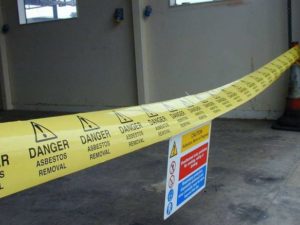
Fig. 11.1 Use of warning tape ("DANGER asbestos removal") and signs to separate an area

Fig. 11.2 Warning signs indicating the dangers and precautions to be taken in pictures and words: "CAUTION asbestos work"; "Unauthorised persons are not allowed to enter - no smoking, eating, drinking"; "Beyond this line, respirators, disposable suits and overalls, including shoes, must be worn".
11.3 EXAMPLES OF LOW RISK WORK
11.3.1 Cleaning the gutter of an asbestos cement roof
Fragments of the guttering of an asbestos cement roof may contain asbestos. Therefore, the removal of the fragments may present a risk of exposure to asbestos and the spread of asbestos contamination. Therefore, a person carrying out this work must be properly instructed.
The personal protective equipment required includes:
- Disposable coverall with cap
- Possibly waterproof overalls (depending on the weather)
- Boots that can be decontaminated (boots without laces)
- Depending on the risk assessment, it will be clear that respiratory equipment is not required. However, disposable respiratory protection (EN 149 FF P3) is recommended.
The tools required include:
- Access platform (e.g. scaffolding or mobile elevating platform)
- Warning tapes and signs
- Bucket with water and cleaning agent
- Watering can or sprayer
- Shovel or trowel
- Rags
- a suitable container for asbestos waste (e.g. a labelled and colour-coded polythene bag) Preparation of the work area should include the following:if the work is to be carried out at height, appropriate precautions should be taken to protect against falling from height access to the work area should be restricted (e.g. by warning strips or signs) the number of workers should be reduced as far as possible, safe means of access should be provided
The gutter cleaning procedure includes the following:
- Mixture of water and detergent
- Sprinkle or spray the cleaning agent dissolved in water into the gutter; however, do not use so much water that a sludge forms in the process.
- Remove the fragments with a shovel or trowel; they should be taken directly to the bin.
- Rewetting of fragments if dry material is found.
Subsequent cleaning includes the following:
- Use damp cloths to clean the equipment
- Use damp cloths to clean access equipment
- Place fragments, used rags and potentially asbestos-contaminated waste in the asbestos waste bin.
Personal decontamination should include the following:
- Disposal of suits as potentially contaminated
- Cleaning of boots from fragments
- Washing/showering
The post-completion inspection procedure should include a thorough examination of the platform and surrounding area to ensure that they have been properly cleaned.
If you employ or supervise people who are going to remove fragments of guttering from asbestos cement roofs, you must assume that these fragments contain asbestos. You must therefore be organised and ensure that :
- the risk assessment includes the asbestos risk and the fall risk, and also takes into account the risk to others (asbestos and falling materials);
- Written work plans are in place and include safe working at height;
- the number of people present is reduced as much as possible;
- these people are properly trained - in relation to the risk of asbestos and the risk of working at height;
- adequate protective and safety equipment is in place;
- measures have been taken for the proper disposal of waste (see Chapter 15);
- rigorous visual inspections were carried out after completion of the work
If you do this work,
- restrict access (e.g. with warning strips or signs);
- Keep the fragments moist, but avoid excessive use of water, otherwise it will be even more difficult to control the spread of contamination;
- place the fragments in a suitable waste container (e.g. a labelled polythene bag).
- Be especially careful if it is windy, as the contamination could spread further with the wind and pose a danger to workers on the roof;
- After completing the work, clean everything thoroughly
Always follow the employer's written work plan for all work. Use safe procedures when working at height.
If you are a labour inspector, you must :
- check that the above recommendations have been implemented and that this is reflected in work plans and training;
- ensure that adequate precautions have been taken for work at height;
- carry out the checks generally listed for low risk work.
11.3.2 Removal of asbestos wallboard
The removal of a single panel of screwed asbestos wall insulation with an area of less than 1 m2. This task falls within the scope of non-notifiable work, provided that the asbestos insulation board has only minor damage, is not thickly painted (so that adjacent boards could be damaged during removal) and is not a ceiling board.
The protective equipment required for this task includes the following:
- Disposable coverall with cap
- boots that can be decontaminated (boots without laces)
- Single-use respiratory protective equipment (EN 149 FF P3)
The equipment required includes the following:
- Strong polyethylene film (250 µm) and insulating tape
- Warning tapes and signs
- Type H hoover (approved for asbestos)
- Magnet and screwdriver
- Sealant, e.g. polyvinyl acetate (PVA)
- Water bucket, sprayer and wipes
- Asbestos warning stickers
- appropriate asbestos waste containers (e.g. a labelled polythene bag)
appropriate
The work area should be prepared as follows:
- Safe access and protection against the risk of falling when working at height.
- Restricted access (close door, use tape and warning signs).
- Install a safety access platform if working at height.
- Examine the tiles. If the tiles are in good condition, proceed as described below. If they are in poor condition or most likely damaged, consider them as reportable work (see Chapter 12).
- Use the 250 µm thick polyethylene sheet to cover surfaces that may be contaminated.
- adequate lighting to remove the sheet:
- locating steel screws with a magnet
- Locate brass screws by carefully scraping off the paint with a local vacuum
- loosen the screws and use local suction
- Carefully loosen one end of the plate and vacuum the rear surface.
- spray the rear surface with sealant
- remove all other screws in the same way
- Lift the panel and put it in the bin or wrap it in 250 µm thick polythene film and apply an asbestos warning label.
Clean the area and equipment:
- Use the H-type hoover to clean the frame.
- To clean the screw holes, use a screwdriver and the type H hoover.
- Use the Type H hoover and damp cloths to clean the equipment.
- Put broken pieces, used rags, polythene film and other waste in the bin.
Follow the personal decontamination procedures as described in the previous example.
Visually inspect the area to ensure that it has been properly cleaned.
11.3.3 Maintenance or removal of asbestos cement materials
If asbestos cement materials are handled correctly, their removal is likely to be classified as low risk work in the risk assessment. However, if the use of power tools is required, the risk assessment may give a different classification. (Typical concentrations for work on asbestos cement are given in Appendix 1). The risk assessment should also list appropriate respiratory and other personal protective equipment.
For maintenance work that may involve contact with asbestos cement materials, the procedure should follow the general procedures in section 11.2.2, and in addition ...
- If possible, avoid the following:
- Attaching objects to asbestos cement; or
- Running wires or cables through asbestos cement.
- protect all adjacent surfaces from contamination
- Keep the material wet when moving or working on it.
- avoid breaking the asbestos cement
- use hand tools rather than abrasives (such as sandpaper grinders) or air tools
- Use abrasives or pneumatic tools at the lowest speed and with local extraction:
- a shroud connected to a local exhaust and fixed around the drill (spring-loaded so that the shroud always remains in contact with the material as the drill penetrates the material).
- or by compartmentalized extraction using the nozzle of a type H hoover approved for asbestos.
- clean the work area (with a type H hoover), and dispose of all bridge pieces as asbestos-containing waste.
When removing asbestos cement materials (during demolition or rehabilitation), the procedure should follow the general procedures described in Section 11.2.2, and :
- asbestos cement must be removed before demolition
- other surfaces must be protected from contamination during rehabilitation.
- asbestos cement materials should not be broken; they should be removed as a whole
- The material should be kept moist during the work, but not too much water should be used as this will lead to the formation of sludge.
- if asbestos cement is removed from a great height, the material must be lowered onto a clean, hard surface.
(a safe access method must be used to remove asbestos cement materials at high altitudes) - asbestos-containing waste and fragments should be removed as soon as possible to prevent the material from breaking up if people walk on it or vehicles drive over it asbestos cement should NOT be pushed together to form larger piles
- asbestos cement fragments should NOT be swept together
- Asbestos cement waste and fragments must be disposed of as asbestos-contaminated waste.
Large pieces of asbestos cement should be disposed of in bulk. They should be placed in a covered container or truck or wrapped in polythene sheeting before disposal.
Small fragments and dust accumulations should be removed with an asbestos approved H-vacuum. Large fragments are collected and bagged as asbestos-containing waste.
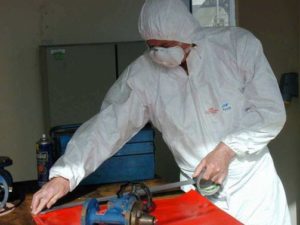
Fig. 11.3 Use of tape and polythene sheeting to cover a work area prior to removing asbestos sealing material from a valve.
 Fig. 11.4 The asbestos seal of a valve is moistened.
Fig. 11.4 The asbestos seal of a valve is moistened.
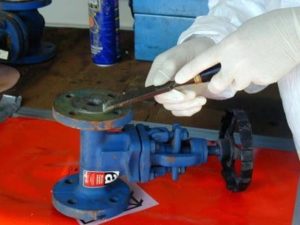
Fig. 11.5 Using hand tools to remove asbestos seal and debris from a valve
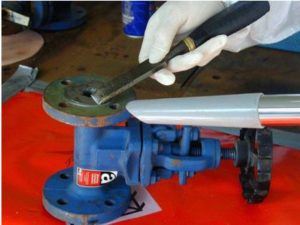
Fig. 11.6 Use of a hoover to immediately capture the dust created when asbestos comes off a valve
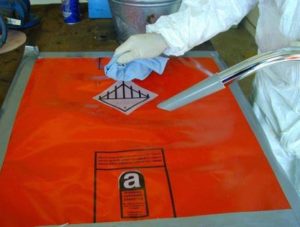
Fig. 11.7 Clean the work area thoroughly with a type H hoover and a damp cloth.
12 NOTIFIABLE JOBS WITH ASBESTOS
12.1 INTRODUCTION
1.2.1 Definition of reportable work
Section 6.3 describes the criteria established by the European Directive on the protection of workers from the risks related to exposure to asbestos (83/477/EEC, as last supplemented by Directive 2003/18/EC) for deciding whether it is possible to derogate from the Directive's provisions on notification and medical surveillance. Thus, work is still considered notifiable unless it involves
This is provided that the work is "occasional low-level exposure of workers" and the risk assessment clearly shows that the exposure level to asbestos in the air in the work area (0.1 fibre/cm3 , 8-hour weighted average concentration (or 1 or 5 hours in some other EU Member States)) is not exceeded, and provided that the work is one of the restricted activities (see definition in Section 6.3). In the case of notifiable work, medical surveillance must be provided (see Chapter 19), and the practical precautions described in this chapter must be followed.
Work involving asbestos removal is clearly notifiable work. EU Directive 2003/18/EC states: "Before carrying out demolition or asbestos removal work, companies must demonstrate their competence in this area. This evidence shall be provided in accordance with national legislation and/or practice.
12.2 GENERAL PROCEDURES FOR WORKS SUBJECT TO NOTIFICATION
11.2.1 Summary of preparatory work
The previous chapters have described the preparatory work required before carrying out works subject to declaration:
- Risk assessment and written work plan (Chapter 5).
- Decision on how to carry out the work, including consideration of all options where asbestos treatment is not required (Chapter 6).
- Instruction of the worker, supervisor/site manager/employer (Chapter 7)
- Equipment (Chapter 8)8)
The general procedure for preventing the risk of exposure when working with asbestos has been described in Chapter 9, e.g. separation and compartmentalisation of the work area, respiratory and personal protective equipment, and washing facilities for workers.
The obligation of medical surveillance for all workers likely to come into contact with asbestos has already been outlined (Chapter 6). The employer's obligations regarding medical surveillance and the purpose and benefits of medical surveillance are described in Chapter 19.
Planning may involve decisions on the removal, maintenance, monitoring or treatment of asbestos-containing materials at each site. Guidance on this varies between EU Member States. In Germany, the recommendation is to remove all asbestos-containing materials. In the UK, the recommendation is to leave asbestos-containing materials in good condition on site. Both approaches have some advantages: removing all asbestos-containing materials is a definitive solution; however, it may result in immediate exposure that could have been avoided. Leaving asbestos-containing materials in good condition is a safe action, provided that effective monitoring and management ensures that any future remediation work is carried out with the necessary precautions regarding asbestos present and exposure.
If, as described in previous chapters, you employ or supervise people who are going to carry out notifiable work with asbestos-containing materials, you must :
- ensure that planning (risk assessment and work plan), preparatory work, instruction, etc. have been carried out and that the necessary documentation is available on site and understood by the workers (Chapters 5 to 7);
- ensure that the safety of others has been considered and is protected;
- have communicated with building managers and others with an interest in ensuring that the work plan is fit for purpose and that no further health or safety risks arise from the implementation of the plan;
- Ensure that the emergency procedures in the work plan incorporate the emergency procedures for the whole site and that key personnel understand all relevant emergency procedures;
- ensure that the detailed site-specific work plan (prepared by a competent person) includes all practical site-specific information (e.g. the route used to remove the waste, any other health and safety risks in the vicinity of the site or arising from exposure to asbestos) (Chapter 5);
- ensure that the equipment (including personal protective equipment and respiratory protective equipment) needed to carry out these practices is available and in good working order and that records of periodic inspections of this equipment by the competent person(s) are readily available (Chapter 8) ;
- ensure that asbestos-exposed workers and their associated documentation can be quickly identified (Chapter 7).
As an employer of persons exposed to asbestos, you must :
- have taken out insurance with adequate cover;
- give all workers the opportunity to undergo an asbestos-related health check-up, before they start working with asbestos and at least once every three years thereafter (Chapter 19);
- ensure that medical and asbestos exposure records are kept for at least 40 years;
- ensure that all other documents are kept in good condition and retained for at least 10 years.
Directive 2003/18/EC requires you to send "a notification to the competent authority (of the EU Member State) in accordance with national laws, regulations and administrative provisions" before you start work; (these regulations may specify when the notification must be made - for example 14 or 28 days before). The notification must include at least a brief description of the following:
- the location of the workplace
- the types and quantities of asbestos used or handled
- the activities carried out and the procedures used
- the number of workers involved
- the start and duration of the work
- the measures taken to limit the exposure of workers to asbestos".
The notice may also contain the following elements
- Work plan
- telephone numbers of contact persons
- dates for other essential elements of the work (e.g. smoke test to check the integrity of the enclosure and asbestos test).
" If there is a change in working conditions which may significantly increase exposure to asbestos dust or dust from asbestos-containing materials, a new notification must be made" . You must also inform the national authorities of any changes to the work plan or any significant changes to working methods.
If you have to carry out reportable work on asbestos-containing materials as part of your job (as defined in section 12.1.1), the preparatory work mentioned in the above chapters must be carried out. Ensure that the following operations have been carried out:
- appropriate training (Chapter 6), (you must have valid training certificates);
- face fit test for the respiratory equipment you will be using ;
asbestos-related medical examination (Chapter 19) within the previous two years.
If you are a work supervisor, you must :
- working proactively on large or complex projects, reviewing and challenging the work plan before starting such work;
- be available for consultation with those developing large projects or having difficulty implementing best practice;
- check that the notification contains the information listed above (in particular, the types and quantities of asbestos-containing materials, the number of workers involved, the time of commencement of the work and the measures taken to limit workers' exposure);
ensure that your own training and equipment are sufficient to protect you from the risk of exposure when visiting work sites.
12.2.2 Summary of construction site management requirements
The practical organisation of asbestos removal work has an important role to play in ensuring that the work is carried out safely.
If work is to be carried out at height on site, safety procedures for working at height (including protection against falls from height, see for example UK Health and Safety Executive publication MISC614) should be defined in the work plan. Procedures may include the use of towers, scaffolding or mobile lifts. Procedures should include protection of equipment from contamination (e.g. by wrapping or covering with polythene sheeting), erection of a tower or scaffold (e.g. use of appropriate protective equipment), safe removal, decontamination of equipment before dismantling the enclosure and inspection/testing (for contamination).
If you employ or supervise people who are going to carry out notifiable work with asbestos-containing materials, you must, as part of your preparatory work :
- Have a competent person supervise the work.
The site supervisor must ensure that the work area is properly controlled and that the following are guaranteed
- adequate partitioning and fencing of the work area
- warning signs and barriers operational at all times
- adequate protection of the safety of workers and others
- adequate monitoring of the air in the enclosure during the work (see Chapter 16) and immediate reporting of the results to the site supervisor
- good working order of the decontamination facility from the start of work on the site until after the enclosure has been dismantled
- an emergency plan containing sufficient details for the specific construction site, e.g. contact details of the local hospital.
You must also have an asbestos test carried out by an independent and competent person.
If you intend to carry out reportable work on asbestos-containing materials (as defined in section 12.1.1), the preparatory work mentioned in the previous chapters must be carried out. Ensure that the following items are provided:
- a written work plan that defines and limits the scope of work and identifies precautions to be taken (Chapter 5);
- the necessary equipment (Chapter 8).8).
You must :
- make sure you understand and can follow the work plan;
- DO NOT use methods that are not specified in the work plan, unless the plan has been supplemented for this purpose;
- liaise with your supervisor/site manager/employer:
- especially if you anticipate or encounter unforeseen difficulties. In this case, stop work immediately until the risk assessment and/or work plan has been reviewed by a responsible person.
- If you experience problems with respiratory equipment, personal protective equipment or control measures, stop work immediately.
- be able to prove your identity if necessary.
If you are a labour inspector, you should :
- check that the work area is effectively partitioned, for example with barriers, signs and controls;
- Check that decontamination equipment is in good condition and on site at the start of the work;
- check that the emergency plan is easily accessible and contains sufficient site-specific information;
- check that the equipment available on site matches the methods described in the work plan (e.g. dusting equipment, hoovers).
12.3 ENCLOSURE FOR THE EXECUTION OF THE ASBESTOS REMOVAL WORK
12.3.1 Purpose and exceptions
Objective
The purpose of an enclosure is to prevent the spread of asbestos contamination and the exposure of others. Regulated access through airlocks and decontamination of personnel and equipment on exit ensure that asbestos contamination remains within the enclosure.
exceptions
Enclosure is required for all asbestos removal work, unless the concentration of asbestos dust is very low, the site is sufficiently isolated (so that other people are not affected) or enclosure is impractical,
For example, in the case of overhead open-air pipe systems or soffits (panels under overhanging rafters) on building roofs. In these cases, alternative methods should be used to prevent the spread of contamination and exposure of others.
12.3.2 Preparatory work and description
Preparation
Before installing an enclosure, prepare the site by taking appropriate precautions (which should be specified in the risk assessment (Chapter 5)) to protect against exposure to asbestos, e.g. personal protective clothing, respiratory equipment and hoovers approved for use with asbestos (Type H hoovers). Asbestos dust may be released during the assembly of the enclosure or access equipment (e.g. scaffolding).
The preparatory work should include the following elements
- Dispose of all non-asbestos waste in the area (where the enclosure, transport routes and waste container are located) as non-asbestos waste.
- Remove or cover items that would be difficult to clean if contaminated and check that these items are not already contaminated.
remove loose fragments of asbestos-containing material and dispose of these fragments as asbestos-containing waste to prevent asbestos-containing material from becoming trapped under the enclosure. - Protection against all other potential hazards (e.g. causes of water and gas leaks).
Block openings (such as air conditioning units, ventilation systems, etc.) to prevent asbestos dust from spreading outside the enclosure. - Ensuring an adequate supply of electricity and water
- One EU Member State requires an independent power supply from the grid by means of a generator (INRS Directive 815) to ensure a safer electrical system during wet removal operations.
- Providing access to equipment
- Ensure that the enclosure does not obstruct escape (fire) routes (e.g. for other people in the building) or that suitable alternative routes are marked.
- Make sure that the smoke detectors are switched off when you perform the smoke test in the enclosure.
- Ensure that electrical equipment in the work area has been de-energised and secured.
- Ensure that emergency power and water systems are in place.
Description
An enclosure can use existing building structures or be a completely self-contained temporary structure. Existing surfaces should be smooth and impermeable or covered with polythene sheeting. In general, an enclosure will be constructed on a durable polyethylene sheet (250 µm thick). The sheeting is disposed of as asbestos-containing material after completion of the work. In France, it is recommended to use two layers of durable polyethylene sheeting. The enclosure should have the following features:
- Covering the floor (to contain the spread of contamination), unless the existing floor is smooth and impermeable so that it can be cleaned.
- An airlock through which personnel can enter and exit the containment area.
- a separate sluice (sometimes called a bag sluice) for removing suitably packaged (e.g. bagged or wrapped) waste from the enclosure
- Ventilation ("negative pressure unit") with high efficiency filter to create a slight negative pressure (20 Pascal is recommended - an EU Member State requires this).
At least 10 Pascal, another at least 5 Pascal inside the chamber and to establish a constant flow of fresh air through the chamber.
- the air change rate in the enclosure should be at least 8 per hour
- observation windows (each with a minimum size of 600 mm x 300 mm) ensuring visibility in all central areas (or a surveillance television if necessary)
- direct connection to the decontamination unit via airlocks, if possible
- additional airlocks, if a direct connection to the decontamination unit is not possible, to ensure separation when changing from the contaminated suit to the intermediate suit worn only during the transition to the decontamination unit.
The enclosure should be as tight as possible to prevent leakage in the event of failure of the negative pressure unit.
The enclosure must have the following characteristics:
it should be weatherproof (if outdoors) and/or be made of orange flame retardant polyethylene sheeting (if there is a risk of ignition and/or restricted access).
These characteristics (weather resistance, fire resistance) of the enclosure should be clearly indicated in the work plan.
The enclosure should only be entered by authorised personnel wearing personal protective equipment and appropriate breathing apparatus
Signs should be provided to indicate the risk of exposure to asbestos and to indicate restricted access and the requirement to wear protective equipment. These signs should be in accordance with national legislation.
If you employ or supervise people who are going to carry out notifiable work with asbestos-containing materials, you must ensure, as part of your preparatory work, that. :
- site preparation and enclosure assembly are carried out by appropriately trained and competent workers
- The risk assessment and work plan address site preparation.
- the preparation work is adequately supervised and inspected
- effective systems are in place to monitor, inspect and maintain the enclosure (see section 7)
If you employ or supervise people who are going to carry out notifiable work with asbestos-containing materials, you must ensure, as part of your preparatory work, that. :
- site preparation and enclosure assembly are carried out by appropriately trained and competent workers
- The risk assessment and work plan address site preparation.
- the preparation work is adequately supervised and inspected
- effective systems are in place to monitor, inspect and maintain the enclosure (see section 7).
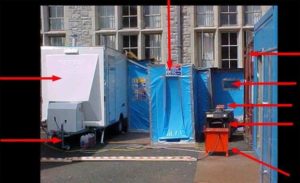
Fig. 12.1 Access to an enclosure. Starting at the top, the arrows point clockwise to the bag closure, waste container, observation window, negative pressure gauge, negative pressure unit, power supply unit, wetting agent and decontamination unit.
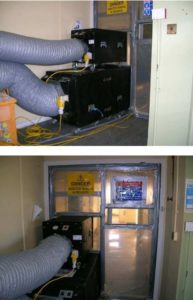
Fig. 12.2 Negative pressure units and air outlet tubes, inspection windows and warnings
12.3.3 checks the condition of equipment and installations related to the work
Workers inside the enclosure must go through the full decontamination procedure each time they leave the enclosure. It is therefore important that someone is available outside the enclosure to :
- establishing communication between people inside and outside the enclosure
- control the entry of personnel through the airlock, check that personnel are authorised and record who has entered and left the enclosure
- organise the movement of equipment within the enclosure and the removal of bagged (or packaged) waste through the airlock.
checked the condition of the equipment and installations associated with the work.
This person does not need to wear the same type of respiratory equipment as the workers inside the enclosure. However, he/she should at least wear disposable respiratory protection (for use with asbestos, e.g. EN FFP3) and a suit to protect against exposure in the event that one of the bags is accidentally damaged. It should be systematically subjected to a decontamination procedure at the end of the shift.
Any equipment brought into the enclosure should be prepared in such a way that any decontamination of that tool can be carried out as easily as possible, for example by attaching plugs to the ends of the scaffold tubes and wrapping the scaffold boards with polythene sheet. However, boards wrapped with polythene sheeting are at risk of slipping when wet. In this situation, thin boards (plywood) are needed as a walking surface. This wood should be disposed of as contaminated waste and should not be reused.
If you are a labour inspector, you must :
- check whether there are records of inspection and monitoring of the enclosure (visual inspection, negative pressure, ventilation, smoke tests);
- ensure that a person outside the enclosure carries out the removal of waste (etc.) and that this person wears appropriate respiratory equipment and protective clothing;
- check that the observation windows are sufficient;
- looking through observation windows and viewing TV surveillance footage to check, for example, that the field of vision is not restricted, that work is being carried out according to the work plan and that waste is removed as soon as the equipment is removed;
- check that the transport routes (from the enclosure to the decontamination unit and from the enclosure to the secure waste storage facility) take the shortest and most appropriate route;
- check transport routes to ensure that they are clear as indicated in the work plan and that no waste is left unattended on the transport route.

Fig. 12.3 Housing for the removal of flue insulation.
12.4 DECONTAMINATION OF PERSONS
12.4.1 The decontamination unit
The decontamination unit should be the first piece of equipment to be installed on site and the last to be dismantled.
The decontamination unit is essentially a "clean changing room" separated by a self-closing door from the shower, which in turn is separated by a self-closing door from a "dirty changing room". The principle of operation is that personnel on the clean side remove their street clothes and put on clean breathing equipment and clean overalls (coveralls with head and neck protection) before passing through the shower section to the dirty side. If possible, the dirty side should be directly connected to the enclosure by an airlock.
Mirrors should be provided at both ends of the decontamination unit to allow workers to check the fit of breathing equipment and suits.
After working in the enclosure (i.e. staff may have been contaminated with asbestos), staff return to the dirty end, clean the suit with an asbestos-approved (Type H) hoover, but keep the respiratory equipment on until they have showered and the outer surface of the respiratory equipment has been cleaned. In some EU Member States (e.g. the UK), workers clean their suits with Type H hoovers at the exit of the enclosure (or in the airlock nearest the enclosure), rather than in the dirty part of the decontamination unit.
All potentially contaminated materials that have either been discarded (coveralls in the dirty part of the decontamination unit) or used (towels or filters in the shower) should be bagged and disposed of as asbestos-contaminated materials.
In general, there is a shower compartment between the "dirty side" and the "clean side".
In an improved layout, there is an additional intermediate space and a second shower room. This ensures a gradual decontamination and release of protective equipment, allowing for optimal user protection.
"The provision of two showers also allows the first shower to be used to wash the coveralls prior to removal. The provision of two showers also allows the first shower to be used to wash the impervious suits before they are removed, and the second shower to be used for final washing after the protective clothing has been removed. Respiratory protective equipment is worn until it has been washed in the second shower. Disposable undergarments worn under washable suits are disposed of as contaminated waste for disposal. Washable suits are stored in the central section.
In one EU Member State (France), decontamination in five sections is also recommended when using disposable suits, unless this can be implemented on site.
As decontamination units are often mobile units, the facilities are usually very compact. However, it is important to provide sufficient space and suitable facilities, such as benches, for the number of workers to ensure proper use.
The decontamination unit should be equipped with negative pressure ventilation. The pressure gradient should be from "clean end" to "dirty end". An air change rate of 30 per hour for the shower and the dirty end is recommended, but some national guidelines accept less. The higher the air change rate, the lower the concentration of asbestos that can be released.
12.4.2 Use of the decontamination unit
The correct use of the decontamination unit is essential to prevent the risk of exposure. It is important that individual users are shown how to use it correctly and that they practise decontamination as part of their training (Chapter 7.2.4). Figure 12.1 shows the use of one decontamination unit with five sections and another with three sections.



Fig. 12.3 Housing for the removal of flue insulation.
If you employ or supervise people carrying out asbestos removal work, you must ensure that :
- that they receive adequate instructions on the use of the decontamination unit;
- Contaminated disposable suits, towels and filters are packaged as asbestos-contaminated waste in the dirty section;
- the unit is maintained in good condition, necessary items (shower gel, nail brushes, towels, hot water, etc.) are available and protection from the weather (e.g. freezing of the water supply) is provided.
If you are carrying out asbestos removal work, you must :
- Have been instructed in the use of the decontamination unit;
- know how to prevent the transfer of contamination from the enclosure to the clean end; in addition, you must know how to apply decontamination procedures correctly, thus avoiding exposure to asbestos during decontamination;
- inform your supervisor immediately if the appliance malfunctions (e.g. pressure drop in the shower, no hot water, ventilation failure).
Figure 12.1 Decontamination of persons in a decontamination unit consisting of five and three rooms respectively.
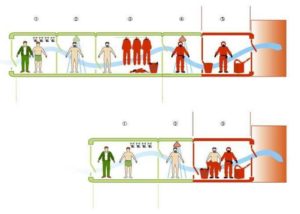


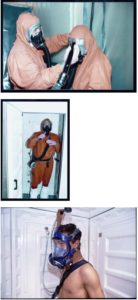


Fig. 12.5 Decontamination using a type H hoover in the shower with an impermeable suit, then showering before removing the respiratory equipment (these photos were kindly provided by INRS; copyright INRS).
12.4.3 Maintenance of the decontamination unit
The decontamination unit must have a clearance certificate (confirming that the unit is no longer contaminated from previous use) before it is put into service on site.
Cleaning of the decontamination unit should be carried out by a competent person wearing clean overalls and a respirator. Contaminated material (towels, filters, suits, etc.) should be bagged and collected - starting at the clean end - so that contaminated material can be disposed of at the dirty end.
The concentration of asbestos fibres in the air is regularly monitored in the areas where workers remove their respiratory protective equipment (Chapter 16).
The decontamination unit should be thoroughly cleaned after each shift. Regular checks should be made to ensure that there is no asbestos dust contamination in the 'dirty section' and, at the end of the work, a full clearance test (similar to the test inside the enclosure) should be carried out before leaving the site or before dismantling work.
12.4.4 Moving from the remote decontamination unit to the enclosure
If the decontamination unit cannot be coupled directly to the enclosure, ensure that no asbestos contamination from the enclosure is released during the transition of workers from the enclosure to the decontamination unit. The procedure for this transition is more appropriate for disposable suits than for washable suits.
Before entering the enclosure, you must :
- Use the decontamination unit (as described above) to remove street clothes and put on a disposable suit (for use in the enclosure) under a transit suit. The transit suits are a different colour from the suits worn in the enclosure. This makes them easier to identify by others. Wear clean shoes for the journey to the enclosure. Inspect and check the breathing equipment and align it correctly using the mirror.
proceed with the enclosure - Remove the clean shoes and transit suit in the outer chamber of the airlock to containment. Hang the suit on a hook or place it in the containers provided in the first chamber. (Do not leave it on the floor!)
- Go to the second chamber of the airlock and put on the shoes to be used in the containment.
- Go through the inner chamber of the airlock into the compound.
When you leave the enclosure, you must :
- Vacuum all visible dust from your personal protective equipment, respiratory equipment and footwear
Enter the inner chamber of the airlock from the enclosure. Brush the shoes in the shoe bath. Rinse breathing equipment in a separate water bath with a sponge or wipe it down wet. - Continue into the central part of the airlock. Remove the suit and shoes from the enclosure. Place the suit in the waste bag as potentially asbestos-contaminated waste. (Or keep it for reuse if you take a break during the shift (e.g. in high temperatures). Do not remove the respiratory protective equipment.
- Continue to the outer chamber and do not remove the transit suit and shoes while wearing the respiratory protective equipment.
- Go to the decontamination unit by the pre-determined route (this route should be determined at an early stage, be short and direct and have as few dangerous areas as possible (e.g. stairs)).
- Enter the dirty end of the decontamination unit. Remove shoes, personal protective equipment and underwear worn in the enclosure. Do not remove breathing apparatus and leave its drive on.
- Move to the shower area while still wearing the respiratory protective equipment. Take a shower and use a sponge to clean the respiratory protective equipment, preventing water from entering the filter openings.
- Remove respiratory protective equipment after cleaning and shower thoroughly. Remove the filter from the respirator and place it in a bag for disposal as asbestos-contaminated waste.
- Dry yourself with a towel. Towels used before leaving the shower area should not be taken to the clean area (they should be left in the shower area or discarded as potentially contaminated). Used towels should be considered potentially contaminated and disposed of accordingly.
- dry off with another towel with a clean end at the end of the day
- put on a transport suit (e.g. for a break) or your street clothes



Fig. 12.6 Mobile decontamination unit
Figure 12.1 Decontamination of persons in a decontamination unit consisting of five and three rooms respectively.






Fig. 12.5 Decontamination using a type H hoover in the shower with an impermeable suit, then showering before removing the respiratory equipment (these photos were kindly provided by INRS; copyright INRS).
12.4.3 Maintenance of the decontamination unit
The decontamination unit must have a clearance certificate (confirming that the unit is no longer contaminated from previous use) before it is put into service on site.
Cleaning of the decontamination unit should be carried out by a competent person wearing clean overalls and a respirator. Contaminated material (towels, filters, suits, etc.) should be bagged and collected - starting at the clean end - so that contaminated material can be disposed of at the dirty end.
The concentration of asbestos fibres in the air is regularly monitored in the areas where workers remove their respiratory protective equipment (Chapter 16).
The decontamination unit should be thoroughly cleaned after each shift. Regular checks should be made to ensure that there is no asbestos dust contamination in the 'dirty section' and, at the end of the work, a full clearance test (similar to the test inside the enclosure) should be carried out before leaving the site or before dismantling work.
12.4.4 Moving from the remote decontamination unit to the enclosure
If the decontamination unit cannot be coupled directly to the enclosure, ensure that no asbestos contamination from the enclosure is released during the transition of workers from the enclosure to the decontamination unit. The procedure for this transition is more appropriate for disposable suits than for washable suits.
Before entering the enclosure, you must :
- use the decontamination unit (as described above) to remove street clothes and put on a disposable suit (for use in the enclosure) under a transit suit. The transit suits are a different colour from the suits worn in the enclosure. This makes them easier to identify by others. Wear clean shoes for the journey to the enclosure. Inspect and check the breathing equipment and align it correctly using the mirror.
- proceed with the enclosure
- Remove clean shoes and transit suit in the outer chamber of the airlock to containment. Hang the suit on a hook or place it in the containers provided in the first chamber. (Do not leave it on the floor!)
Go to the second chamber of the airlock and put on the shoes to be used in the containment. - Go through the inner chamber of the airlock into the compound.
When you leave the enclosure, you must :
- vacuum all visible dust from your personal protective equipment, respiratory equipment and footwear
Enter the inner chamber of the airlock from the enclosure. Brush the shoes in the shoe bath. Rinse breathing equipment in a separate water bath with a sponge or wipe it down wet. - Continue into the central part of the airlock. Remove the suit and shoes from the enclosure. Place the suit in the waste bag as potentially asbestos-contaminated waste. (Or keep it for re-use if you take a break during the shift (e.g. in high temperatures). Do not remove the respiratory protective equipment.
- continue to the outer chamber and do not remove the transit suit and shoes while wearing the respiratory protective equipment.
- go to the decontamination unit by the pre-determined route (this route should be determined at an early stage, be short and direct and have as few dangerous areas as possible (e.g. stairs)).
- Enter the dirty end of the decontamination unit. Remove shoes, personal protective equipment and underwear worn in the enclosure. Do not remove breathing apparatus and leave its drive on.
- Move to the shower area while still wearing the respiratory protective equipment. Take a shower and use a sponge to clean the respiratory protective equipment, preventing water from entering the filter openings.
- Remove respiratory protective equipment after cleaning and shower thoroughly. Remove the filter from the respirator and place it in a bag for disposal as asbestos-contaminated waste.
- Dry yourself with a towel. Towels used before leaving the shower area should not be taken to the clean area (they should be left in the shower area or discarded as potentially contaminated). Used towels should be considered potentially contaminated and disposed of accordingly.
- Dry yourself with another clean-ended towel at the end of the day
- Put on a transport suit (e.g. for a break) or your street clothes
- Leave the decontamination unit via the outer door at the clean end



Fig. 12.6 Mobile decontamination unit
12.5 DUST SUPPRESSION TECHNIQUES
12.5.1 The basics
Where asbestos-containing materials are to be removed, dust suppression techniques should be used to prevent asbestos fibres from becoming airborne. The technique for removing asbestos-containing materials should be chosen carefully and according to the situation. For example, wet removal techniques are generally preferred, but are not suitable in the presence of live electrical or mechanical equipment. One EU Member State recommends disconnecting all electricity from the external grid and then restoring it via an independent generator. If chemicals are present on site, the possible reactions of these chemicals with water should be taken into account. Wetting agents combined with water can make surfaces very slippery, increasing the risk of slipping and falling, especially when working at height. The use of an anti-freeze wetting agent is necessary in freezing conditions.
Equipment (used for dust suppression and control) should be of appropriate quality (for example, it should meet quality standards such as the British Standards Institution (PAS) quality standard), be in good working order and be properly maintained.
12.5.2 Removal of moisture
Different application techniques are used to dampen asbestos-containing materials These include airless sprays for wetting the surface or for thin, porous materials and injection needles for thicker materials or materials with an impermeable surface. A wetting agent must be added to the water to effectively wet the asbestos.
The injection method is suitable for materials such as thermal insulation and sprayed coatings, as well as other asbestos-containing materials with impermeable surfaces (e.g. painted asbestos insulation boards). The injection needles can be placed on a solid base (for flat surfaces) or on a flexible feed tube.
(for curved or irregular surfaces). For inaccessible areas, a single point injection (on a rod) may be necessary.
The injection should be carried out at low pressure (3.5 bar) so that the asbestos-containing material is wetted by capillary action. In this way, unnecessary spillage of water is avoided. It is important to allow sufficient time for the entire material to be thoroughly immersed. If the material still has dry areas, this can lead to significantly higher concentrations of asbestos in the air in the workplace.
The size and design of the needles should be chosen according to the shape of the asbestos-containing material, e.g. long needles with holes on the long side for linings/insulations thicker than 1 cm.
The needles must be correctly aligned to ensure good coverage of the surface. The individual needles should be positioned close enough to each other so that no dry areas are created. The positioning should be such that the spread of water is assisted by gravity (e.g. needles along the top of horizontal pipes; needles at intervals of about one metre in horizontal rings around vertical pipes).
If the coating/insulation has a hard surface that needs to be drilled to allow the needles to be injected, dust suppression techniques, e.g. wetting with airless sprayers, should be used for the drilling process; if wetted beforehand, the water can be absorbed.


Fig. 12.7 The asbestos insulation of the pipe shows several layers and the penetration of the wetting agent
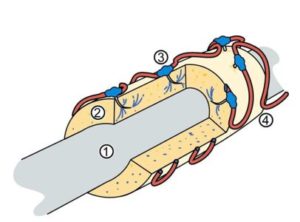

Fig. 12.8 Diagram of the injection system: (1) tube, (2) insulating material, (3) injection needle fed by a (4) flexible conduit.


Fig. 12.9 The injection system: each needle has several openings from which water comes out. This illustration was provided by the UK HSE (HSG247). Material protected by Crown copyright, reproduced with the permission of the Controller of the HMSO and the Queen's Printer for Scotland.
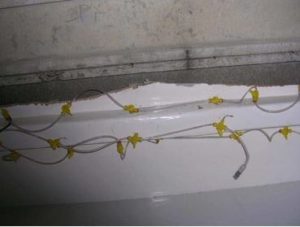

Fig. 12.10 Example of a multi-point injection. This system is used to wet the sprayed asbestos.
Airless sprays (i.e. sprays that do not use air or propellant to carry water) can be used to wet the surfaces of porous materials (e.g. insulation sheets, ropes, gaskets) and to prepare any material prior to drilling so that needles can be inserted for injection. Wetting with airless sprays can also be used for asbestos insulation boards (for removal under local ventilation) and for small fragments during cleaning.
Damaged coatings/insulation can easily come off during injection. Such a damaged section can be wrapped in polythene film (or cling film and tape) to prevent the fragments from spreading.
It may be necessary to remove the metal sheathing from the asbestos-containing insulation to expose the insulation for injection. If thea metal sheath can be pierced, the injection method should be used as described. If the jacket can be removed without damaging the insulation, this is an easier method. In this case, dust generation should be controlled with airless sprays and local extraction.
Uniform wetting is difficult if the material has internal cracks or variable porosity. If cracks are clearly visible, place the needles carefully to maximise wetting efficiency. If the porosity is different, adjusting the flow rate may help. It may be necessary to wrap asbestos-containing materials to retain water and ensure complete wetting.
Large, high-capacity industrial heating systems can present the following problems:
- Extensive and complex piping system; complete sealing of the enclosure is difficult or impossible.
- large quantities of very thick asbestos insulation (e.g. 1 m)
- large quantities of asbestos waste and sludge
Sufficiently moistened asbestos-containing materials have a pasty consistency and can be removed in this form.
The removal of wet asbestos-containing materials is best done with hand tools (e.g. scrapers, scissors, screwdrivers). No power tools (such as cut-off grinders and sandpaper grinders) may be used to remove asbestos-containing materials!
Work should be carried out in a systematic manner: removed materials should be immediately bagged or packaged; work should be carried out from top to bottom to avoid recontamination of clean surfaces (e.g. ceilings/beams first, then walls and finally the floor).
After removing most of the material, small residues may remain on the surfaces. Sometimes the residue will stick (for example, on rough pipe surfaces). It is preferable to use hand tools to remove asbestos residues, but power tools may be necessary for some very sticky residual materials. In these cases, they should be used at the lowest setting and with a dust suppression technique (foam, airless spray or local exhaust ventilation).


Fig. 12.11 Bagging of asbestos waste directly at the removal site to prevent the spread of asbestos and minimise exposure to asbestos.
If you employ people to remove asbestos-containing materials, you must provide effective supervision to ensure that :
- safety precautions are observed;
- only the removal methods specified in the work plan are used;
- Work methods are NOT changed, unless previously verified in the risk assessment and work plan;
- asbestos removal work is carried out in accordance with best practice (as defined in this guide).
During asbestos removal :
- Decide on a work sequence that minimises the possibility of recontamination of the cleaned surfaces, e.g. start with the ceilings/beams, then the walls and finally, make sure that the filters are not wet, otherwise their filtering effect is impaired.
- Good organisation is very important. Remove waste as soon as it is produced. The wooden supports of asbestos ceilings often have nails in them. Make sure that these nails do not protrude in such a way that someone can walk on them.
- Remove asbestos-containing materials so that they are broken as little as possible in the process. For example, if an asbestos tile is fixed with 4 nails, it should be removed intact - the corners with the nails should not be damaged. The nails should be removed one by one (with dust suppression as described in chapter 11).
Use ONLY the methods specified in the work plan
DO NOT use power tools on asbestos-containing materials (except for special and restricted applications where this is specified in the risk assessment and work plan).
If you are a work supervisor, you must check that the work has been implemented according to the work plan, e.g., the work plan is in place:
- Observe the work through the observation windows;
- Check that the tools on site or in the enclosure comply with the work plan;
- Check that NO power tools are used
12.5.3 Controlled dry removal
Wet removal is the best method and should always be used, except in special circumstances. If wet removal is not possible, controlled dry removal is an alternative. This involves removal using other methods to control the release of dust, such as local ventilation or wrapping of isolated parts and cutting and removal of the entire section (known as "wrap and cut").
It is possible to pack and cut Thermally insulated pipe sections where the pipe is to be disposed of with the thermal insulation as asbestos waste. For this purpose, the thermally insulated pipe is wrapped in polyethylene film. It may be necessary to remove small localised sections of the thermal insulation to allow the pipe to be cut. Removal of this part of the thermal insulation creates a risk of exposure to asbestos at this point and therefore the whole work should be carried out in an enclosure (see 12.3.1 for exceptional cases where an enclosure is not required). This technique is only suitable if the pipe sections are of appropriate size and the contents of the pipes/containers have been drained.
Glove bagsThe glove bags, which are made of durable clear plastic, have built-in long-sleeved plastic gloves that allow an outside worker to handle the items inside. After securing the glove bag around the item to be removed, the worker can use tools with the bag to remove the asbestos. The material removed from the item is collected in the lower part of the glove bag. The bag should be fitted with a watertight zip so that the waste can be enclosed in the lower part of the bag when the work is finished. The bag can only be used once and should then be disposed of with the waste. If possible, the glove bag should be used with a slight vacuum.
A procedure for removing tools from the glove bag (e.g. after finishing the job) should be established. This is done by placing the tools in one of the gloves, which is then pulled out, leaving the tools in the plastic glove that has been pulled out. When the glove is tied, the tools remain in a kind of plastic bag. A second knot in the glove creates a section that can be opened with minimal risk of asbestos release. The tool bag can be opened either in the next glove bag or in a bucket of water for cleaning.
The glove bag protects the worker but is not sufficient protection to override the requirement for personal protective equipment and respiratory equipment or the requirement for an enclosure, as asbestos can escape from a bag if it is damaged.
Glove bags are commercially available in different models.


Fig. 12.12 Glove bag for the controlled removal of an asbestos coating (These photos were kindly provided by INRS; copyright INRS).
Direct disposal by negative pressure systems is an appropriate and effective method of removing loose asbestos (e.g. thermal or acoustic insulation). The asbestos waste is transported to an off-site collection unit by means of a negative pressure transport line. The necessary negative pressure is generated by specially designed equipment.
If this line is connected to a bagging unit which is outside the enclosure, then the bagging unit must have its own enclosure and the workers in the bagging unit must wear full respiratory protective equipment and personal protective equipment and undergo full decontamination procedures (as for asbestos removal work).
If this type of equipment is used, the work plan should clearly indicate how blockages in the negative pressure transport line will be removed. For example, the pipe should be carefully plugged at both ends and pulled into the asbestos removal area where the blockage can be removed.
12.6 ENCAPSULATION AND CLOSURE
If it has been decided to secure some or all of the asbestos-containing material by encapsulation or closure, this process may involve a risk of disturbing the asbestos-containing material. Encapsulation can be achieved either by applying a thin sealant coating, a thick sealant coating or by impregnating the asbestos containing material with a curing liquid. However, the initial wetting may already cause such additional weight that the asbestos-containing material loosens and falls off. In doing so, it causes dust. In general, the same precautions should be applied to the encapsulation of asbestos-containing materials as to the removal of asbestos.
Enclosure may mean enclosing the asbestos-containing material in a structure away from the asbestos-containing material. The risk assessment for this task should determine whether the work may disturb the asbestos containing material. This will influence the decision as to whether the work should be notified and therefore carried out in accordance with the precautions described in this chapter, or whether the precautions set out in chapter 11 are sufficient.
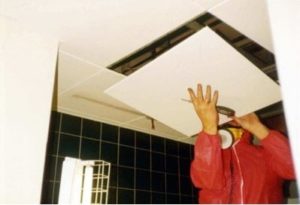

Abb. 12.13 Vorsichtiges Lösen einer Asbest-Deckenplatte. Diese Abbildung wurde von dem UK HSE zur Verfügung gestellt.
12.7 INSPECTION, MONITORING AND MAINTENANCE OF THE ENCLOSURE
12.7.1 Systematic inspection and monitoring
Scheduled monitoring and maintenance of the enclosure should be carried out. A trained person with relevant expertise may be designated as the responsible person. The monitoring system should specify measurements and frequency. Monitoring records should be reviewed regularly by management.
Monitoring should include the following elements:
- Visual inspection the integrity of the enclosure
- Before starting the workFor example, the checks should cover the correct structure, seals, airlocks, connections and the effectiveness of seals around 'obstacles' such as pipes, ducts and cables.
- Daily inspections before shifts should check for damage or malfunction of joints or connections and maintain adequate negative pressure inside the polyethylene walls of the enclosure.
Regular visual inspections are the first step in preventing leaks.
- Smoke tests to detect potential leaks should be carried out with the exhaust switched off. The purpose of this test is to detect where leaks may occur (e.g. in the event of exhaust failure).
- A differential pressure of 5 pascals is normally sufficient to prevent leakage to the outside. This small negative pressure and the readings can be affected by external influences (e.g. strong wind affecting the pressure in and around the building). One EU Member State requires a minimum pressure of 10 pascal and recommends a pressure difference of 20 pascal.
- Measurements of asbestos concentration These measurements should be repeated at certain intervals, depending on how dangerous a leak is. For example, if the enclosure is in a busy building and the surrounding areas are used, daily monitoring would be appropriate. However, if the enclosure is in an empty building, monitoring at much longer intervals would also be sufficient. The risk assessment should take into account the extent of exposure in the presence of a leak and determine the frequency of monitoring accordingly. In many situations, weekly monitoring is appropriate. Regular monitoring can confirm and ensure that no leakage has occurred and can be very important, especially in critical situations (e.g. a compound near a school).
- The exhaust system should be checked by a competent person before use and at regular intervals. The pre-filter can be replaced if it is clogged. However, a clogged pre-filter is also an indication that the dust suppression is not working as intended. It is important to ensure that the filter is installed correctly. The exhaust system should be serviced regularly (every six months) by a competent person. If the high efficiency filter has been installed correctly and is working to specification, no asbestos dust should be released. Occasional testing of the air near the air outlet is nevertheless useful (e.g. if the high efficiency filter has just been changed). Immediately after changing the high efficiency filter, test the performance of the exhaust to ensure that the filter has been correctly installed with effective seals. (The performance of the filter can be tested with a safe replacement aerosol, e.g. dioctyl phthalate (DOP); this test is normally carried out by a contractor when servicing this equipment).
12.8 WASTE DISPOSAL
12.8.1 Removal of packaged waste from the enclosure
For asbestos-containing waste, use colour-coded bags labelled as asbestos waste in accordance with national asbestos waste legislation. Waste bags should NOT be filled to capacity and the contents should be
be damp. The bags should be carefully closed to prevent air from escaping and then sealed.
Bagged or packaged waste is removed from the enclosure through an airlock separate from the staff airlock. The waste lock is often referred to as a "bag lock" and usually consists of three chambers.
The sealed waste bags (or packaged items) are rinsed (with a hand shower) and wiped clean in the inner chamber of the three-chamber baghouse. The cleaned bags are placed in the central chamber of the airlock and stored in another transparent bag, which is then sealed. Double bagged waste is placed in the outer chamber of the airlock. The waste is removed from the outer chamber by workers outside the chamber wearing appropriate respiratory protective equipment (approved for asbestos work) and taken directly to the secure waste storage area (e.g. a lockable waste container).
Care should be taken to ensure that the frame of the bag closure does not have any sharp corners or points, as sharp edges can damage the bags (or packaging) containing the waste.
12.8.2 Spill prevention
Packaged waste leaving the enclosure must be stored in a manner that is safe from accidental or intentional damage. Once the waste has left the bag closure, the packaged waste should :
- never be left unattended until it is safely encapsulated
- be routed by the shortest route to a secure storage location (e.g. a lockable waste container or a lockable vehicle), and the route should be clearly defined (so that it can be inspected at the end of the process).
Care must be taken not to tear or damage the bags:
- Do not overfill the bags
- Waste containers should not contain sharp objects
- Packaged waste should not be handled carelessly (e.g. do not throw the bags in the bin).
12.8.3 Use of personal protective equipment during disposal
As described in section 12.3.3, a worker standing outside the enclosure can remove the packaged waste from the bag closure and move it to a safe storage location. This worker should wear appropriate personal protective equipment and respiratory protective equipment as specified in the risk assessment and work plan.
12.9 CLEANING AND COMPLETION OF WORK
All equipment and the entire work area must be kept clean during the execution of the work. In doing so, asbestos-containing waste should be bagged as soon as it is produced. Work areas should be cleaned and tidied up after each shift.
tidy up. Cleaning methods should not create dust. Type H hoovers approved for asbestos work should be used to extract the dust. Appropriate attachments should be used for the respective surfaces.
Fragments should be moistened before collection. Shovels and rakes can be used for broken pieces (brooms are not suitable for this). Wet rags or cloths can be used to clean surfaces. In this case, the wiping water should be changed regularly to avoid contamination of the entire surface. Once the surfaces have been wiped, they should be allowed to dry before being submitted for final inspection.
The Type H hoover should not be used to collect wet materials as the moisture will destroy the high efficiency filters that prevent the release of fibres.
Once the asbestos has been removed and all asbestos waste, tools and equipment have been removed from the enclosure, a final cleaning of the enclosed area should be carried out. Surfaces should first be vacuumed with a type H hoover and then wiped with damp cloths and wipes.
Tarpaulins and sheets that have been used to cover the facility, equipment, floors or other surfaces can then be cleaned. These tarpaulins and sheets (but really only these tarpaulins and sheets) should be sprayed with a sealant to prevent dust from being released when these parts are moved.
All equipment used in asbestos removal work should be cleaned before being moved from the premises. Where possible, equipment such as scaffolding panels or mobile lift platforms should have been protected (e.g. with thin sheeting, polythene sheeting) before being brought into the enclosure. These sheets and tarpaulins can be covered with a sealant and should be disposed of as asbestos-contaminated waste. All surfaces that are not fully protected should be cleaned with an H-vac and clean water. Contaminated water should be removed by a water filtration system.
Finally, the contractor should carry out a thorough inspection to ensure that all asbestos-containing materials to be removed have been removed and that the work area has been cleaned of visible fragments and deposited fine dust. The only items remaining in the enclosure at this stage are packaged waste that could not be taken outside by bagging, a type H hoover, equipment to access higher areas of the enclosure, and rags and waste bags for additional cleaning that may be commissioned by an independent expert carrying out an asbestos test (see Chapter 16).
In some EU Member States (UK and Ireland), the independent expert carries out a 4-step procedure to assess whether asbestos work has been satisfactorily completed before the premises can be re-occupied:
- A preliminary check of the condition of the site and the completion of the work, comparing the work carried out with the details in the work plan and examining the condition of the transport routes and areas around the compound for signs of contamination.
- A thorough visual inspection inside the enclosure to ensure that asbestos-containing materials have been removed, that surfaces are clean and that any asbestos-containing materials remaining on site are in accordance with the work plan.
- Monitoring of the air in the enclosure to ensure that the concentration of asbestos in the air remains below a specified limit (0.01 fibres/ml, measured by phase contrast microscopy).
- A final assessment, which will include a thorough visual inspection after disassembly and removal of the enclosure. This final assessment will ensure that all fragments exposed during the dismantling of the enclosure have been properly removed.
The procedures in the different EU Member States may include the issuing of a document or certificate by the expert indicating the results of each stage. The Contractor may be asked to countersign the document.
When the above procedure has been satisfactorily completed, the surveyor will also carry out an examination of the decontamination unit before it is removed from the site. The examination will include a visual inspection in all sections and an air check in the shower and in the section where contaminated items have been left.
Detailed guidance for inspectors carrying out these procedures has been published by the UK Health and Safety Executive (2005) in guidance document HSG248.
In some EU Member States, analysis of the air by means of an electron microscope is required after completion of the asbestos removal work (see Chapter 16.2: Description of the meaning of the different measurement methods).
If you are a labour inspector, you should check that :
- the work was reported in accordance with legal requirements
- the work plan is available, understandable and includes the recommendations given at this stage
training and refresher courses have been set up - good working practices are encouraged
- the scope of work is as specified in the work plan
- personal data and photographs of workers are consistent with medical and training records
good site management and supervision procedures are in place.
You should also check that :
- each person on site has a correct version of the work plan that they can understand (for example, if one of the workers does not speak the local language, you should find out if that worker has received a copy in a language they can understand. They should also have a means of communication with their line manager that is sufficient for enquiries about their duties under the plan).
- Practical procedures are used to minimise dust generation and prevent exposure to asbestos and the spread of contamination. For example, any asbestos insulation board that has been removed should be intact, and all screw holes (visible through the packaging) should be in a condition that indicates careful removal of the screws.
Also consider the practical controls described in section 11.2.2 (e.g. on asbestos-containing materials which should be removed as intact as possible).
If best practice is not applied on a project or site, give clear instructions on the necessary measures and recommendations. If failure to apply best practice results in significant exposure of workers or others to asbestos, the safest course of action is to stop work.
13 DEMOLITION WORK
Demolition work is covered by the Council Directive on the minimum safety and health requirements for mobile construction sites (92/57/EEC). This Directive requires that due regard be paid to public health, safety and welfare when setting up a construction site.
This guide focuses on the prevention of asbestos exposure risks and therefore does not seek to cover the requirements arising from the general requirements of the Mobile Works Directive. However, those involved in the management of demolition work should be aware of the requirements of this Directive.
EU Directive 83/477/EEC, as last amended by Directive 2003/18/EC, states that "Before carrying out demolition or asbestos removal work, companies must demonstrate their expertise in this field. This evidence shall be provided in accordance with national legislation and/or practice.
The Directive also requires that before demolition work begins: "employers, after obtaining, if necessary, appropriate information from the owner, shall take the necessary measures to identify materials likely to contain asbestos. If there is reason to believe that a material or building contains asbestos, the relevant provisions of this Directive must be followed. These provisions include the following: "asbestos and/or asbestos-containing materials shall be removed before the application of demolition techniques, unless such removal would result in a greater risk to workers than if the asbestos and/or asbestos-containing materials were left in situ."
When carrying out demolition work that may involve asbestos-containing materials, the key points to consider are
- Who can be harmed by the work?
- How will we separate the work?
- What control measures will we use?
- Can asbestos removal work and demolition work be carried out side by side?
- How will the contractor's workers carrying out asbestos removal work be protected from the risks associated with demolition work?
- How will the contractor's workers carrying out demolition work be protected from the risks associated with asbestos removal work?
The execution of the demolition work should include the following steps:
- Identify where asbestos containing materials are present on the demolition site through asbestos surveys, inspections and/or review of existing site information.
- Asbestos-containing materials accessible before the start of demolition work.
- In areas where no asbestos-containing material could be determined, allow for demolition preparations, i.e. removal of non-structural and non-asbestos containing elements, suspended floors, partitions, floor coverings, etc.
- During this work, voids are exposed, B. cable penetrations and mechanical penetrations. These networks should be traced to ensure that all connections to other structures not earmarked for demolition have been cut, e.g. a pipeline that runs through several buildings but not all of which are earmarked for demolition.
- Now recheck these areas for asbestos-containing materials not previously identified If asbestos-containing materials are found, stop the demolition work. These materials must be removed by a specialist asbestos contractor.
Prior to demolition work, identify areas where asbestos-containing materials are inaccessible or cannot be safely removed, B. asbestos-containing materials that form or insulate structural elements.
Develop a strategy for the type and timing of removal of these asbestos-containing materials, B. Removal of asbestos-containing panels may require the removal of concrete slabs. This can be done in an enclosed work area with properly trained personnel wearing appropriate respiratory equipment. It is not always practical to erect an enclosure in these circumstances.
If asbestos-containing materials are unexpectedly discovered, a safe system of work must be put in place to ensure that the asbestos-containing materials are removed with minimal exposure to people working in the vicinity.
Different techniques can be used for demolition work:
Dismantling - This involves dismantling the structure in the reverse order of assembly. Non-structural materials (e.g. asbestos cement wall cladding and roof panels) are normally dismantled first, followed by dismantling the structure. This is done either by unscrewing it manually, or by using a torch and lifting and access equipment (e.g. scaffolding or a mobile elevating platform).
By machines - Large machines equipped with a variety of special tools can perform a range of demolition operations. Machines equipped with hydraulic shears can carefully cut through previously inaccessible structural beams. These machines can lift beams covered with a layer of asbestos insulation to the ground, where the removal of the asbestos insulation can be carried out under controlled conditions. Machine demolition is often preferred because the people involved in the work are at a safe distance from the building structure during demolition. Large brick or stone buildings can be knocked down by specialised machinery. Asbestos-containing waste can be handled on the ground under controlled conditions, thus avoiding the risks associated with working at height.
Remote demolition using wrecking balls or similar equipment.These methods are used in the demolition of dangerous structures. They protect the safety of the workers involved in the demolition work. Nevertheless, the risk assessment should indicate the expected level of asbestos exposure and the methods to control and reduce it.
Remote demolition with explosives
Blasting is more difficult to control (in terms of the spread of contamination) and is therefore only a last resort for the demolition of dangerous structures. However, the use of explosives for building demolition is constantly increasing.
This method has the advantage that no personnel are in the building when the explosives are detonated. However, large amounts of dust are generated, so all asbestos-containing materials must be removed beforehand, unless the risk assessment indicates that some materials should remain in place.
For fire damaged structures, all of the above techniques can be used.
All asbestos removal work within a demolition project should be treated as low risk or reportable work, depending on the results of the risk assessment, and appropriate precautions should be applied. Demolition work is in no way less demanding than other asbestos removal work.
In some cases, the demolition of a building involves the removal of electrical equipment, transformers, etc. Due to the value of the waste materials, these pieces of equipment must be removed intact and transported to another location for further processing. The components of electrical switchgear may contain asbestos. Therefore, those involved in the dismantling of this equipment should be aware of the possible presence of asbestos-containing materials, be able to recognise them and use best practice to minimise exposure to asbestos dust.
If you employ people for demolition work where asbestos-containing materials may be present, you must ensure that :
- effective coordination between the different activities on the site; in particular, you must ensure that demolition work does not endanger workers carrying out asbestos removal work and vice versa;
- Asbestos removal work is carried out according to best practice (as described in this guide);
- all workers are properly trained (so that demolition workers can identify materials that may contain asbestos and know what to do);
- asbestos-containing materials exposed during demolition work are removed and disposed of as asbestos-contaminated waste.
If you are working on a demolition site where asbestos-containing materials are present, you must. :
- Be aware of the risks of asbestos exposure;
- Knowing how to recognise materials containing asbestos;
- Understand the procedures to prevent you from being put at risk by the demolition work;
- Use best practice for asbestos work, as described in this guide.
If you are a labour inspector, you must :
- Check that an effective system is in place to coordinate demolition and asbestos removal work;
- Check that the demolishers :
have been informed of and understood the risks associated with asbestos
have been trained in asbestos-containing materials and their detection
- Check that asbestos removal work is carried out according to best practice (as outlined in Chapter 12);
- Check that the relevant national legislation is respected.
14 THE EMPLOYEE AND THE WORKING ENVIRONMENT
14.1 INTRODUCTION
The difficulties in adequately protecting workers from the risk of asbestos exposure may increase if working conditions are complicated by other factors, such as extreme temperatures. High temperatures can occur when working on hot equipment or in enclosures heated by direct sunlight. Low temperatures occur in unheated areas in cold weather or in cold climates.
In addition, the use of tight or non-permeable suits can also reduce the body's heat production. This can lead to overheating-related illnesses during strenuous work, even in relatively temperate climates. If a humid atmosphere is created by the use of water for wet ablation, this may limit the normal dissipation of body heat through perspiration. Hot environmental conditions may cause workers to remove their clothing, reducing the effectiveness of protection against asbestos contamination.
The disposable suits used for asbestos removal offer relatively little protection against the cold. Considerable metabolic heat can be generated during the physically demanding work of removing asbestos-containing materials. In contrast, less physically demanding cleaning operations end up generating little metabolic heat, which means that cold-related problems are paramount.
14.2 DER ARBEITNEHMER
A worker's physical condition can affect their ability to work safely in these environments.
The ability of workers to wear and use respiratory protective equipment can be affected by changes in personal factors. For example, a beard or weight loss may affect the facial fit of the respirator.
In the case of a pregnant worker, it is also important to consider how pregnancy will affect the particular issues involved in carrying out asbestos work: the facial fit of respiratory equipment and the physical ability to cope with these extreme temperatures.
14.3 THE NATURE OF THE WORK
Musculoskeletal disorders are the most common cause of work-related sick leave in the EU. The handling of heavy loads is often the cause of work-related back pain. Compliance with the provisions of the EC Directive on manual handling of loads (90/269/EEC) should help to minimise these risks when carrying out asbestos-related work. Working in uncomfortable positions (e.g. bending or twisting) can cause back pain and is a major problem when working in cold environments.
Three factors - force, position and repetition - can lead to discomfort and injury in the upper limbs. The risk in this respect is increased by, among other things, unsuitable tools, repetitive work with flexion and extension of the wrists and excessive work with raised arms.
Discomfort or musculoskeletal problems may be caused by a worker not properly securing his or her respiratory equipment to the face.
14.4 THE WORKING ENVIRONMENT
14.4.1 Hot environmental conditions
Adverse health effects of working in hot environmental conditions may include
- Burns from contact with hot surfaces or from heat radiation.
- External effects: Swelling of the feet and ankles, sweat blisters.
- fainting due to a drop in blood pressure in the brain (which can be serious if the person concerned is kept in an upright position) and obvious risks of falling, as well as difficulty in helping an unconscious worker with a respirator.
- Muscle cramps, nausea and vomiting due to salt loss from excessive sweating.
- Heat exhaustion caused by dehydration due to excessive sweating. Symptoms include fatigue, dizziness, nausea, headaches, breathing problems, extreme thirst, muscle cramps.
- Heat stroke, an acute and potentially fatal condition caused by a rise in core body temperature above 40°C. This condition can occur suddenly and without warning or be heralded by headaches, dizziness, confusion, weakness, restlessness or vomiting.
Measures to be taken to reduce the risks associated with hot environmental conditions are as follows:
- Minimise heat sources (e.g. turn off hot appliances as often as possible).
Limit heat conduction and radiation (e.g. thermal insulation of hot surfaces, heat radiation shields to reflect heat). - Higher air change rates (e.g. increased general ventilation or local exhaust ventilation).
cooling (e.g. fresh outside air, compressed air or air conditioning) - local cooling with standing fans (make sure this does not raise dust)
- Rotation of workstations and regular breaks in a cooler area
- Prevent dehydration by drinking water regularly before work, during breaks and after work.
- Training in heat stress awareness, associated symptoms, safe working practices and emergency procedures.
- Monitoring the temperature and health status of workers (e.g. measuring core body temperature) with the participation of
Two European standards (EN 27243 and EN ISO 7933) can help in carrying out a risk assessment for the effects of hot environmental conditions. EN 27243 is easier to apply, but does not include provisions for clothing, personal protective equipment or respiratory equipment. EN ISO 7933 includes the effects of skin coverage, but not the effects of clothing permeability. The British Standard BS 7963 gives guidance on the adjustments needed to account for the effects of personal protective equipment on thermal balance.
14.4.2 Cold ambient conditions
For work in cold environments, ISO/TR 11079 provides guidance on the thermal insulation required for clothing and ISO 9920 provides an estimate of the temperature characteristics of clothing. Reportable work on asbestos-containing materials in cold environmental conditions may require the provision of disposable undergarments to be worn underneath disposable or washable coveralls.
Exposure to cold temperatures without adequate protection can lead to hypothermia. Hypothermia is the fall in core body temperature to a level where muscle and brain function are impaired. Mild hypothermia (core body temperature between 37°C and 35°C) causes mild shivering that is not self-controlled, interferes with complex movements (but not walking or talking) and reduces blood flow to the body surface (causing vasoconstriction). Moderate hypothermia (core body temperature between 35°C and 34°C) causes drowsiness, loss of fine motor skills (especially in the hands), slurred speech, irrational behaviour and an indifferent attitude. These symptoms may also contribute to the incorrect use of tools or protective equipment, which increases the risk of exposure when working with asbestos.
Severe hypothermia can quickly lead to death.
If you employ people whose work may involve exposure to asbestos under the conditions described in this chapter, you should :
- monitor the condition of workers and have a system in place to ensure that worker safety is not compromised (e.g. due to a reduction in the effectiveness of respiratory equipment because workers have stubble, or by reassessing the chosen respiratory equipment if a worker's physical condition has changed significantly)
- examine practical problems related to the reduction of risks that lead to musculoskeletal disorders or that prevent the correct use of respiratory protective equipment
Introduce effective systems to produce acceptable temperatures in the workplace, such as
- Cooling/heating
- Thermal insulation against hot elements
- appropriate protective clothing
- additional ventilation
- a working schedule with adequate breaks
- provide adequate workplace supervision to monitor the well-being of workers.
If your job involves possible exposure to asbestos and physically demanding working conditions (because of the temperature or physical effort required in the job), you should :
- be aware of the importance of maintaining protection against asbestos exposure
- be aware of the effects of hot environmental conditions and use the equipment provided to protect against them (thermal insulation, protective clothing, extra ventilation, regular breaks, drinking water during breaks and before work)
- use protective equipment to protect against cold environmental conditions (heaters, if necessary, thermal protective clothing, breaks, if necessary)
- always use the good practices in this guide to protect yourself from the risk of asbestos exposure.
If you are a labour inspector, you should :
- Check whether effective measures have been put in place to reduce exposure to heat
- Check whether working conditions may affect the effective use of respiratory protective equipment
- Check that national legislation in this area is respected.
15 WASTE DISPOSAL
15.1 INTRODUCTION
The Directive on the protection of workers against asbestos (83/477/EEC, as last amended by Directive 2003/18/EC) requires in Article 6 that (a) "the exposure of workers to dust arising from asbestos or materials containing asbestos in the workplace shall be minimised, in particular by the following measures" (concerning transport and disposal of waste):
- "Asbestos, released asbestos dust or materials containing asbestos must be stored and transported in appropriate closed containers;
- The waste must be collected and removed from the workplace as soon as possible in suitable closed containers, labelled to indicate that the contents contain asbestos... ...This waste must be managed in accordance with Council Directive 91/689/EEC of December 1991 on hazardous waste.
According to the Waste Framework Directive, EU Member States must support the prevention or reduction of waste and the resulting hazards by promoting the development of clean technologies, technical improvement of products and new disposal technologies. In addition, they should prohibit uncontrolled disposal. An adequate network of disposal facilities must be established in cooperation with other Member States. The best available technology should be used, which should also not lead to excessive costs.
15.2 PROBLEMS
Packaged asbestos-containing waste must be labelled as asbestos-containing waste in accordance with EU Directive 1983/478/EEC of 19 September 1983.
Once the packaged waste has been collected in secure storage facilities (e.g. lockable containers) at the construction site, it should be transported safely to an authorised waste disposal site. Transport must comply with national regulations on the transport of dangerous goods. This may include requirements for securing the load, marking the vehicle, prior written agreement with the authorised waste disposal site, emergency procedures for dealing with spills (e.g. waste packed inside the container), training of the driver and a person with relevant expertise in the transport of dangerous goods.
In the EU, asbestos is currently disposed of in landfills or vitrification plants. In some EU Member States, civil engineering pits can be used for the disposal of asbestos waste.
Landfills/monitored pits
In these disposal facilities, the asbestos is buried. Records kept by the disposal facility allow the material to be traced from its source to its position in the facility. In some Member States, for example, the waste is sealed with concrete.
An assessment of the potential exposure of workers in the facility involved in the transport or placement of bagged waste should be carried out and regularly verified by personal sampling. Workers shall be protected from the risk of exposure (e.g. due to damage to bagged or packaged waste during transport or storage) by taking appropriate protective measures (e.g. provision of high efficiency particulate filters for vehicle cab air conditioning and use of appropriate respiratory equipment, protective clothing and changing or decontamination facilities approved for use with asbestos).
Glazing
Vitrification is carried out in a plant where asbestos waste is treated at high temperatures and transformed by chemical change into a vitrified and inert end product that can be used as aggregate for road construction or other appropriate applications. This process is considered to be an effective way of removing the risk of asbestos exposure from the final product. However, vitrification requires much more energy than other processes.
15.3 TRANSPORT REGISTRATION
Directive 84/631/EEC requires the use of a detailed consignment note indicating in detail the source and composition of the waste, the transport route, the measures taken to ensure safe transport and the existence of a formal agreement with the consignee of the waste.
15.4 WHAT YOU NEED TO DO
If you employ people whose work involves the disposal of asbestos-containing waste, you must. :
- carry out a risk assessment (as described in Chapter 5) to assess their likely exposure and the potential work-related exposure of others;
- provide written instructions for work practices that reduce worker exposure to airborne asbestos fibres;
- use best practice (as defined in this guide);
- ensure that workers are properly trained and informed about the risks;
- ensure adequate monitoring of the concentration of airborne asbestos fibres in order to determine the level of exposure of workers and other persons;
- keep records of asbestos disposed of (e.g. location of waste in landfill sites);
- ensure that workers are provided with and properly use appropriate personal protective equipment (e.g. respiratory protective equipment and coveralls where required by the results of the risk assessment);
- national legislation on asbestos work.
If your work involves handling asbestos-containing waste, you must :
- Be aware of the risks of exposure to asbestos due to your training;
- Know the importance of minimising exposure;
- follow written instructions that minimise the risk of exposure to asbestos;
- Use best practice for working with asbestos, as outlined in this guide.
If you are a labour inspector, you must :
- Ensure that an adequate risk assessment is in place;
- ensure that adequate written work procedures are in place to prevent or reduce the risk of exposure to asbestos;
- ensure that there are records of the results of the monitoring of workers' exposure to asbestos;
- check compliance with relevant national regulations.
16: MONITORING AND MEASUREMENT
16.1 INTRODUCTION
This chapter describes the monitoring and measurement of air concentrations, which must be carried out by a competent person or a specialised company. The explanations are intended to
- help the employer to ensure that air monitoring is adequate
- help the employer, worker and supervisor to understand the different objectives of air monitoring
- help explain what the results of the measurements mean
- to highlight the implications of air sampling and measurement of airborne asbestos fibre concentrations
- show how different measurement techniques (to determine the number of fibres in the sample) affect the data obtained
16.2 INDOOR AIR SAMPLING AND SAMPLE ANALYSIS METHODS
In ambient air sampling, a measured volume of air is passed through a filter that removes airborne fibres. The filter is then examined under a microscope to determine the number of fibres. In this way, the concentration of fibres in the air can be determined.
The European Directive on the protection of workers from the risks related to exposure to asbestos (83/477/EEC, as last supplemented by Directive 2003/18/EC) stipulates that sampling must be carried out by suitably qualified personnel and that samples must be analysed in laboratories equipped for fibre counting. It further specifies that the filter must then be analysed according to a method published by the World Health Organisation (1997), i.e. by counting the fibres under a phase contrast light microscope or by another method giving equivalent results. The phase contrast light microscope method is used in most EU Member States.
Other types of microscopes can also be used for filter analysis. Electron microscopes offer higher magnification (i.e. it is possible to detect more fibres of very small diameters that would not be visible under an optical microscope) and they can distinguish asbestos fibres from other fibres (e.g. organic or synthetic fibres). Therefore, counts from different types of microscopes may also give different estimates of concentration. There are two types of electron microscopes: the scanning electron microscope and the transmission electron microscope.
Each microscopy method has its own advantages. An optical microscope can always be transported ready for use and can be used on site to quickly obtain results. This is particularly advantageous when results are needed immediately, for example to check the tightness of the enclosure. However, phase contrast light microscopes have the disadvantage that they count all fibres, including non-asbestos fibres, and therefore determine the concentration of all fibres (not just asbestos fibres).
Electron microscopes offer higher magnification and better resolution and can therefore detect finer fibres that are not visible under a phase contrast light microscope. The concentrations measured by an electron microscope can therefore be higher than those measured by an optical microscope.
The scanning electron microscope can distinguish between asbestos and non-asbestos fibres by determining the chemical composition of the fibres. This can help to detect lower concentrations after asbestos removal has been completed if other types of fibres (e.g. organic fibres) are also present in the air.
The transmission electron microscope is used to determine the type of asbestos in a fibre (amosite, crocidolite, chrysotile, etc.) by determining the chemical composition and crystal structure of the fibre. The transmission electron microscope has the highest magnification to observe the smallest fibres. However, this method of analysis is the most expensive and time consuming. It also involves a difficult and time-consuming technique to prepare the sample.
In one EU Member State, it is necessary to have measurements carried out with a transmission electron microscope to confirm that the concentrations are below 0.005 fibres/cm3. This is done as part of the tests to confirm that a building can be re-occupied (INRS ED815). Another Member State requires measurements with a scanning electron microscope. Several Member States use measurements with a phase contrast light microscope (e.g. to confirm that concentrations are below 0.01 fibres/cm3 ) as part of the tests to confirm the success of asbestos removal work.
16.3 AIR MONITORING OBJECTIVES
Stationary air sampling can be used to determine the ambient fibre concentration when there is no active exposure to asbestos, e.g. before work begins. This method is also used for handling asbestos-containing materials that remain on site.
Individual monitoring measures the concentration of fibres in the breathing zone of workers. This measurement is used to check whether the protection factor of the personal respiratory protective equipment is adequate.
The European Directive on the protection of workers from the risks related to exposure to asbestos (83/477/EEC, as last supplemented by Directive 2003/18/EC), stipulates that :
"The employer shall keep a register of workers carrying out the activities (referred to in point 6.3, which must be notified), indicating the nature and duration of their activities and the hazards to which they have been exposed. Each worker shall have access to the information concerning him contained in this register. Workers and/or their representatives in the undertaking or establishment must be able to consult the general non-personal information contained in this register.
The records referred to in point 1 and the personal medical records referred to in Article 15(1) (see Chapter 19) shall be kept after the end of exposure, in accordance with national provisions.be kept for at least 40 years after the end of the exposure, in accordance with national legislation and/or practice.
The records referred to in point 2 shall, in accordance with national law and/or practice, be made available to the competent authority when the undertaking or establishment is closed.
Regular monitoring can also identify workers whose work practices are causing unusual levels of asbestos fibres and thus help to identify areas where work practices need to be improved.
Sometimes samples are also taken from the general work area. These samples, together with personal monitoring, are used to determine the concentration of asbestos fibres in the air where the work is being carried out.
Monitoring the working environment should include the measurement of the concentration of airborne asbestos fibres in areas where there is a possibility of exposure of workers if they do not wear personal respiratory protective equipment. One EU Member State sets the measurement at twice a week in the department where workers remove their respirators (INRS ED815).
Leakage control can be carried out during asbestos work if an enclosure is in place. This is a secondary measure to visual inspection and smoke testing of the enclosure. This test is used where weak points on the enclosure are suspected or where 'sensitive' areas (e.g. used areas) are present nearby. Monitoring can detect high fibre concentrations that may be related to a release from the enclosure. Background testing prior to the commencement of work is useful in determining whether a leak test measurement reflects a release or simply a background concentration.
Checking for leaks may be particularly necessary if items such as cables, pipes and risers pass through the enclosure. Planning should include a buffer zone between those involved in asbestos work and others in the building. Leakage control should be carried out in this buffer zone.
Leakage testing should be carried out more frequently at 'high risk' times of the job (e.g. at the start, at times of greatest asbestos exposure, and at times of exposure to weak points in the enclosure). If sufficient monitoring confirms the existence of a sealed and conducted enclosure, these tests can be reduced accordingly or abandoned altogether.
Control of cleanliness is carried out in conjunction with a visual assessment of the cleanliness and integrity of the containment system. National regulations and practices may require a cleanliness check after asbestos removal, before the site is released for normal use, demolition or remediation.
16.4 SELECTION OF A MONITORING ORGANISATION
ISO/IEC 17025 certified laboratories have the required quality systems in place. Laboratories must also participate in an external proficiency testing programme.
for fibre testing (e.g. the national systems of the UK (RICE), Spain (PICC-FA), Belgium and France) or in an international system (such as AFRICA).
16.5 WHAT YOU NEED TO DO
If you employ or supervise people who remove asbestos, you must :
- ensure that testing (personal exposure testing, cleanliness testing, etc.) is carried out by a competent and accredited person or organisation;
- ensure that airborne fibre monitoring, if required, is carried out by a person or organisation independent of the contractor carrying out the asbestos work;
- make the work plan available to the inspection organisation prior to the arrival of the workers carrying out the work on the site;
- have implemented a monitoring strategy appropriate to the nature, scale, location and complexity of the asbestos work;
- keep a register of workers carrying out work subject to declaration, recording their activities and the exposures to which they have been subjected, keep this register for at least 40 years and make it available in the following manner::
- the competent State authorities and the doctor in charge of the medical examination
- individual workers who wish to have access to documents concerning their own exposure
- workers' representatives with regard to non-personal information
- ensure that personal exposure monitoring is carried out regularly, in accordance with national requirements, and that records are kept for at least 40 years;
- react immediately to the results obtained by the monitoring organisation.
If you are carrying out work to remove asbestos, you must :
Cooperate with your employer and the chosen testing body by wearing a personal sampling device and ensuring that its operation is not impaired, and maintain your normal working practices during the sampling period;
provide accurate information about your work and methods during the personal sampling period;
help the inspection body to identify weak points in the enclosure during leakage tests;
assisting the inspection body in carrying out a thorough visual inspection of the enclosure as part of the asbestos control, B. use of auxiliary equipment, etc.
Do not move, adjust or handle the air monitoring equipment;
follow the instructions of your employer/site supervisor and take immediate corrective action if the monitoring organisation detects an elevated fibre concentration in or around the work area.
If you are a labour inspector, you must :
- seek evidence that supervision is appropriate to the nature, scale, location and complexity of the asbestos work;
- ensure that mandatory testing is carried out by a competent and, if necessary, independent organisation or person;
- specify that regular personal follow-up is carried out and that records are kept for at least 40 years;
- review the record of workers' activities and exposure (e.g. ensure that it is realistic and adequate);
- review the results of air monitoring tests to determine whether action has been taken in situations where high fibre concentrations have been detected.
16.6 INFORMATION
The European Directive on the protection of workers from the risks related to exposure to asbestos (83/477/EEC, supplemented by Directive 2003/18/EC) requires that :
- measures are taken to enable workers and/or their representatives to consult the results of measurements of asbestos concentrations in the air and to receive an explanation of them
- if the results of air concentration measurements exceed the established limit value (0.1 fibres/cm3 calculated as a weighted average over a reference period of 8 hours):
- the workers concerned are informed as soon as possible of any overruns and their causes
- workers and/or their representatives in the undertaking are consulted on the measures to be taken or, in an emergency, are informed of the measures taken
17 OTHER PEOPLE INVOLVED
17.1 WHO ELSE IS INVOLVED?
Most of the chapters in this guide are aimed at people whose work involves or may involve the risk of exposure to asbestos. However, there are other important people involved in the process. These include
- the client (who commissions the work)
- people involved in the construction of the building and building services (architects, civil engineers, facility managers)
- persons carrying out subcontracting work in connection with the preparation of asbestos removal or encapsulation work.
- people working or living in a building where asbestos work is being carried out
- anyone likely to be affected by the work, e.g. passers-by, the general public.
17.2 PARTICIPATION IN THE PLANNING OF ASBESTOS-RELATED WORK
17.2.1 Selection of a contractor
For the client looking for a contractor, it is important to examine the technical standards of the contractors' bids in order to avoid the following risks
- Spread of asbestos contamination
- Exposure to other people during work
- Provision of adequate documentation to ensure that all subsequent monitoring and maintenance of encapsulated or enclosed materials is effective and efficient.
The disturbance caused by encapsulation or removal of asbestos is very significant. It is therefore important that the area is thoroughly inspected so that all asbestos containing materials can be treated at the same time.
When planning asbestos-related work, the services and activities of those involved in the construction of the building and in the maintenance of the buildings (architects, civil engineers, facility managers) must also be taken into account, as they may have to be modified or re-provided:
- Water, gas, electricity, central heating, air conditioning, ventilation, fire alarms - may need to be modified to ensure that the whole building functions safely during asbestos work.
- Water, gas, electricity, sewerage, telephone - may need to be provided for asbestos work.
17.3 PRESERVED ASBESTOS-CONTAINING MATERIALS
If some or all of the asbestos-containing materials are left in place (either in their original good condition or encapsulated, impregnated or enclosed), then :
- materials left in place should be inspected regularly, but at least once a year (frequency to be determined by the risk assessment), to ensure that they are still in good condition; inspections should be documented.
- the presence of this material must be taken into account in any future alterations or installations that may affect it. This includes a management system so that the material is always taken into account when a contractor or worker undertakes work that affects the building structure.
- a reporting system should be established so that any accidental damage to equipment is recorded.
17.4 REPETITION
After removal of the material, completion of the work must be confirmed by clearance tests carried out by an independent body. This includes a visual inspection and air sampling by an independent person to determine the concentration of fibres in the air. In most EU Member States, air samples are examined using a phase contrast microscope and the concentration must be less than 0.01 fibres/cm3 for the reference to be established (see description of procedures in Chapter 16).
In addition, one Member State requires that after the removal of weakly bound asbestos, the customer arranges for a new air test to measure the concentration of asbestos fibres. In this Member State, the conditions are satisfactory when the measured asbestos fibre concentration is less than 0.005 fibres/cm3 in a sample examined by transmission electron microscope.
17.5 WHAT NEEDS TO BE DONE
If you employ or supervise people who are in any way involved in work with asbestos-containing materials, you must. :
- ensure that these workers understand their role in preventing or reducing exposure to themselves and/or others;
- ensure that all asbestos-containing materials left on site are properly controlled, managed and maintained;
- ensure that the technical offers of potential contractors demonstrate high standards of control and prevention of asbestos exposure;
- Ensure that you meet the requirements of government regulations and legislation, for example, subcontractors must be licensed in some EU Member States.
If you are carrying out work involving asbestos, you must :
- Understand your role in preventing or reducing exposure to yourself and/or others;
- use the good practices described in this guide if your own work involves contact with asbestos-containing materials.
If you are a labour inspector, you must :
- seek evidence that all parties involved have fulfilled their obligations in relation to prevention and abatement of asbestos exposure (e.g. specifications in subcontracts, provisions for diversion of supplies, inspection records and schedules, availability of records of asbestos containing materials, etc 😉
- verify that all parties have the licences or certificates required by national legislation.
- Review the tests to determine whether action has been taken in situations where high fibre concentrations have been detected.
18 ASBESTOS IN OTHER PLACES (VEHICLES, MACHINERY, ETC.)
18.1 INTRODUCTION
Asbestos-containing materials have been used in a wide range of applications and locations (as described in Chapter 4). Therefore, additional considerations are necessary in some situations. However, the general approach still applies, namely Risk assessment and written work plan (Chapter 5), deciding what to do and whether the work should be reported (Chapter 6), adequate training (Chapter 7), and containing and preventing asbestos exposure (Chapters 9 and 11 or 12).
18.2 DIVERSITY OF APPLICATIONS
Other uses of asbestos that may require special measures are
- Vehicles (trains, ships, military vehicles such as tanks).
- facilities and equipment
- Decorative coatings (which cannot be clearly classified as reportable or non-reportable).
18.3 PROCEDURES TO AVOID EXPOSURE TO ASBESTOS
The same procedures apply regardless of the asbestos work:
- Avoid exposure by containing the released dust (e.g. enclosure with airlock).
- dust suppression at source (e.g. complete wetting of all materials)
- local exhaust ventilation (e.g. use of fans with high efficiency particulate filters or shading of the
- (e.g. tool movement with an H-type hoover [so-called "shadow suction"])
- personal protective equipment and appropriate respiratory equipment
- proper decontamination of persons
- proper disposal of waste
18.4 PROBLEMS IN SPECIFIC CASES
Some of the problems encountered in some of the above-mentioned work include the following:
- access or restricted space inside vehicles more generally (e.g. asbestos in ship engine rooms or restricted spaces inside military vehicles), restrictions on the provision of effective containment, the provision of equipment and the removal of bagged or packaged waste.
- the need to provide access (to asbestos-containing materials) through the steel structures of ships or vehicles
- The difficulty of dismantling certain products and the need to weld or cut to reach asbestos-containing materials.
Asbestos has been used in decorative ceiling and wall coverings in some EU Member States. Recent assessments of the work-related risks in these cases suggest that, provided appropriate techniques are used to minimise exposure to asbestos
- can be considered low risk work and therefore do not need to be declared Exposure to asbestos is avoided or reduced as follows:
- Remove the coated panel as a whole and, if necessary, cut the coating with a sharp knife to remove the panel.
- Spraying with a wetting agent, followed by careful (manual) scraping with a shaded vacuum.
- if the wall is covered with wallpaper, use a steam stripper to soften and remove the material.
- NO dry sanding and NO power sanding tools.
- Wet blasting techniques are NOT suitable for initial cleaning but can be used for final residue removal.
If you employ people who are exposed to asbestos in their work, you must. :
- use best practice (as described in this guide);
- ensure that workers are properly instructed and informed about the risks;
- ensure that workers understand the importance of minimising exposure;
- carry out a risk assessment to determine potential exposure to asbestos;
- provide written instructions (work method) to prevent or reduce exposure as much as possible;
- Provide adequate and appropriate equipment (dust suppression and personal decontamination, see Chapter 12);
- organise adequate monitoring by an independent expert to determine the extent of actual exposure;
- comply with government legislation regarding work where exposure to asbestos is possible.
If your work involves potential exposure to asbestos, you must have received appropriate training to be able to... :
- are aware of the risks of exposure to asbestos;
- understand the importance of keeping exposure to a minimum;
- follow written instructions to avoid or reduce exposure;
- use the best practices described in this guide for working with asbestos.
If you are a labour inspector, you should :
- ensure that an adequate and appropriate risk assessment is in place;
- check that the written instructions include an effective method for preventing or reducing exposure to asbestos;
- check that appropriate equipment is available (e.g. for dust suppression and personal protection) so that the written work procedures can be followed;
- ensure that equipment is inspected and maintained at sufficient intervals to ensure that it remains in good working order;
- verify that national legislation is respected in this respect.
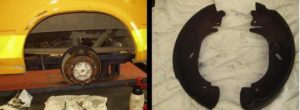

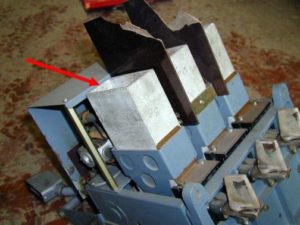

Fig. 18.2 Asbestos-containing components in high-voltage switchgear
19 HEALTH MONITORING
19.1 MONITORING
The European Directive on the protection of workers from the risks related to exposure to asbestos (83/477/EEC, as last supplemented by Directive 2003/18/EC) stipulates in Article 15 for workers carrying out work subject to declaration (as determined in Section 6.3):
"Before a worker is exposed for the first time to dust from asbestos or materials containing asbestos, he must be given the opportunity to undergo a health check. This health check-up must include a special examination of the chest."
"These health checks must be available at least once every three years during the exposure period.
A personal medical file shall be kept for each worker in accordance with national law and practice, as referred to in the first paragraph.
The health check includes a visit by a specialist (usually appointed in accordance with national legislation) with knowledge of the medical characteristics of asbestos work.
Some medical conditions are signs that the worker is not fit enough to work safely in the conditions present when working with asbestos. These include illnesses that may suddenly affect the ability to work in the enclosure with respiratory protective equipment. Respiratory or cardiopulmonary conditions may also affect the ability to perform strenuous work while wearing respiratory protective equipment and in hot environmental conditions.
In some EU Member States (e.g. the UK), the asbestos examination certificate only confirms that the examination has been carried out. If the risk assessment identifies risks such as arduous work and hot environmental conditions, the employer must also offer a "fitness for work examination" in addition to the asbestos health check.
The check-up may include a chest X-ray. This is done either by a conventional X-ray examination or by computer tomography (CT). CT scans obtain X-ray data from different angles around the body and then use computer calculations to produce cross-sectional images of the body. Conventional X-ray examinations result in radiation exposure equivalent to 10 times the normal daily background radiation (cosmic radiation and naturally occurring radioactive materials). CT results in a higher radiation exposure than conventional X-ray examinations and is approximately equivalent to the natural radiation exposure over 3 years (see for example http://www.radiologyinfo.org/content/safety/xray_safety.htm#measuring_dosage). Unnecessary radiation exposure should be avoided. The physician will consider the patient's interest in deciding whether and when to perform such an examination.
EU Directive 83/477/EEC, as last supplemented by Directive 2003/18/EC, stipulates that "Information and advice is given to workers on the health surveillance they may undergo after exposure.
In short, the medical examination ensures that the worker is fit for work without compromising the effectiveness of the measures designed to protect him or her from the risk of exposure to asbestos. Asbestos-related diseases often occur many years after exposure; only then can the signs of asbestos-related disease be detected during the health check-up and the patient be properly informed.
19.2 WHAT NEEDS TO BE DONE
If you employ or supervise people whose work may involve exposure to asbestos, you must. :
- Give workers whose work involves exposure to asbestos the opportunity to have a health check-up before starting work, and then at least every three years (or more frequently if specified by national legislation) until exposure to asbestos has ceased;
- Advise, or even request, a health examination (in accordance with national legislation) for other workers who may be exposed to asbestos, to determine whether, on the basis of the risk assessment (see Chapter 5 and Section 3) ;
- report notifiable diseases (such as asbestosis, lung cancer or mesothelioma) in workers who have been exposed to asbestos, in accordance with national legislation;
- keep a record of health conditions and medical examinations. National legislation may specify the information that must be recorded (e.g. the performance of an asbestos-related medical examination) and the minimum period for which records must be kept.
- Keep records for at least 40 years. If your business closes, ensure that medical records are kept in an appropriate and secure location (this may be specified in national legislation).
- Ensure that all workers can be clearly identified in these records.
If you are likely to be regularly exposed to asbestos in the course of your work, you should. :
- assume that health checks are carried out and ask your employer if they are not;
- be aware of the importance of health checks to ensure that you are fit enough to work in the conditions often associated with asbestos work, for example by wearing respiratory protective equipment in hot environmental conditions;
- ask the doctor if you would like to be informed about the risks of asbestos exposure;
- Be aware that an x-ray does not mean that work practices are safe, as it can take 10-15 years for the effects of asbestos exposure to show signs that can be detected by an x-ray;
- take the opportunity to get advice from your doctor on how to take the best possible care of your health.
You can decide whether non-medical data will be collected from you for epidemiological studies. We recommend that you have this data collected, as it is a way of checking the effectiveness of health protection programmes.
If you are a labour inspector, you must :
- Check that the above recommendations have been implemented - this can be seen from the extent to which workers understand the health effects of asbestos exposure - that the worker and employer understand the necessary fitness requirements and that medical records are complete and clear;
- Check for compliance with national legislation in this regard.
20 BIBLIOGRAPHY
Asunción Calleja , Santos Hernández, Exposición al amianto en operaciones de retirada y demolición Guía de prevención. Centre de Seguretat i Condicions de Salut, en el Treball. Generalitat de Catalunya, Barcelona. Departamento de Salud Laboral de CC.OO. Realización Paralelo Edición, s.a. ISBN 84-87851-62-2 Depósito Legal M-18824-2002
Council Directive of 19 September 1983 on the protection of workers from the risks related to exposure to asbestos at work (second individual Directive within the meaning of Article 8 of Directive 80/1107/EEC) [Richtlinie des Rates vom 19. September 1983 über den Schutz der Arbeitnehmer gegen Gefährdung durch Asbest am Arbeitsplatz (Zweite Einzelrichtlinie im Sinne des Artikels 8 der Richtlinie 80/1107/EWG) (83/477/EWG) (OJ L 263, 24.9.1983, p. 25), mit Ergänzung durch Richtlinie 2003/18/EG der Europäischen Parlaments und des Rates vom 27. März 2003 L 97 48 15.4.2003. http://europa.eu.int/eur-lex/en/consleg/pdf/1983/en_1983L0477_do_001.pdf
Und für die französische und deutsche Version:
http://europa.eu.int/eur-lex/fr/consleg/pdf/1983/fr_1983L0477_do_001.pdf http://europa.eu.int/eur-lex/de/consleg/pdf/1983/de_1983L0477_do_001.pdf
COMMISSION DIRECTIVE 1999/77/EC of 26 July 1999 adapting to technical progress for the sixth time Annex I to Council Directive 76/769/EEC on the approximation of the laws, regulations and administrative provisions of the Member States relating to restrictions on the marketing and use of certain dangerous substances and preparations (asbestos). [RICHTLINIE DES RATES 1999/77/EG vom 26. Juli 1999 zur sechsten Anpassung an den technischen Fortschritt von Anhang I der Richtlinie des Rates 76/769/EWG zur Angleichung der Rechts- und Verwaltungsvorschriften der Mitgliedstaaten für Beschränkungen des Inverkehrbringens und der Verwendung gewisser gefährlicher Stoffe und Zubereitungen] http://www.legaltext.ee/text/en/PH0638.htm
Council Directive 92/57/EEC of 24 June 1992 on the implementation of minimum safety and health requirements at temporary or mobile construction sites (eighth individual Directive within the meaning of Article 16 (1) of Directive 89/391/EEC). [Richtlinie 92/57/EWG des Rates vom 24. Juni 1992 über die auf zeitlich begrenzte oder ortsveränderliche Baustellen anzuwenden Mindestvorschriften für die Sicherheit und den Gesundheitsschutz (Achte Einzelrichtlinie im Sinne des Artikels 16 (1) der Richtlinie 89/391/EWG) Official Journal L 245 , 26/08/1992 P. 0006 - 0022. Finnische Spezialausgabe: Kapitel 5 Band 5 P. 0165. Schwedische Spezialausgabe: Kapiel 5 Band 5 P.0165
Corrigendum to Council Directive 92/57/EEC of 24 June 1992 on the implementation of minimum safety and health requirements at temporary or mobile construction sites (eighth individual Directive within the meaning of Article 16 (1) of Directive 89/391/EEC) [Corrigendum zur Richtlinie 92/57/EWG des Rates vom 24. Juni 1992 über die auf zeitlich begrenzte oder ortsveränderliche Baustellen anzuwenden Mindestvorschriften für die Sicherheit und den Gesundheitsschutz (Achte Einzelrichtlinie im Sinne des Artikels 16 (1) der Richtlinie 89/391/EWG) (OJ Nr. L 245 vom 26. 8. 1992). Official Journal L 015 , 23/01/1993 P. 0034 - 0035
Albracht G Schwerdtfeger A. Herausforderung Asbest. Universum Verlagsanstalt.
Bard D, Boyle T, Burdett G. Final report on the development of practical guidelines for the training of asbestos removal workers. Report for DGV under agreement number VG/1999/5190, Health and Safety Laboratory (Jetzt Buxton, UK).
British Standards Institution. PAS 60 Part 1 Equipment used in the controlled removal of asbestos-containing materials - Part 1: controlled wetting of asbestos-containing materials - Specification. Verfügbar unter BSI Kundenservice +44 (0)208 996 9001. www.bsi- global.com
British Standards Institution. PAS 60 Part 2 Equipment used in the controlled removal of asbestos-containing materials - Part 2: Negative Pressure Units - Specification. Verfügbar unter BSI Kundenservice +44 (0)208 996 9001. www.bsi-global.com
British Standards Institution. PAS 60 Part 3 Equipment used in the controlled removal of asbestos-containing materials - Part 3: Operation, cleaning and maintenance of class H vacuum cleaners - Code of practice. Verfügbar unter BSI Kundenservice +44 (0)208 996 9001. www.bsi-global.com
Institut National de Recherche et de Securité (INRS). (1st edition 1997; edition of April 2005.) Exposure to asbestos in maintenance work; Guide de Prevention. ED 809. www.inrs.fr
Institut National de Recherche et de Securité (INRS). Works of removal or containment of asbestos or materials containing it. Guide de Prevention. ED 815. www.inrs.fr
Institut National de Recherche et de Securité (INRS). Diagnosis and treatment of asbestos-based flockings. Guide Methodologique. ED 734. www.inrs.fr
NÅR DU STØDER PÅ ASBEST. (Wenn Sie auf Asbest treffen). Branche ArbejdsmiljøRådet; for Bygge & Anlæg, Ramsingsvej 7,2500 Valby; e-mail sekr@bar-ba.dk. www.bar-ba.dk
UK Actuaries (2004). UK Asbestos - the definitive guide. http://www.actuaries.org.uk/files/pdf/proceedings/giro2004/Lowe.pdf
UK Health and Safety Executive Surveying, sampling and assessment of asbestos containing materials. MDHS 100 http://www.hse.gov.uk/pubns/mdhs/pdfs/mdhs100.pdf
UK Health and Safety Executive. (2001) Asbestos essentials task manual: task guidance sheets for the building maintenance and allied trades. HSG210, HSE Books ISBN 0 7176 1887 0
UK Health and Safety Executive. (2001) Introduction to asbestos essentials: comprehensive guidance on working with asbestos in the building maintenance and allied trades. HSG213. HSE Books ISBN 0 7176 0901 X
UK Health and Safety Executive. (2004) Managing asbestos: your new legal duties. INDG223(rev3).
UK Health and Safety Executive. (2004) Asbestos alert for building maintenance, repair and refurbishment workers. INDG 18 ISBN 0 7176 1209
UK Health And Safety Executive (2003) 2/03 Method statement aide memoire. Herausgegeben durch die HSE Asbestos Licensing Unit. http://www.hse.gov.uk/aboutus/meetings/alg/policy/02-03.pdf
UK Health and Safety Executive. Controlled asbestos stripping techniques for work requiring a licence. HSG189/1. HSE Books.
UK Health and Safety Executive. The selection, use and maintenance of respiratory protective equipment - a practical guide HSG53. HSE Books ISBN 0 7176 1537 5
UK Health and Safety Executive. (1999) Selection of suitable respiratory protective equipment for work with asbestos, Kostenlos. HSE Broschüre INDG 288: http://www.hse.gov.uk/pubns/indg288.pdf
UK Health and Safety Executive HSE Information Sheet MISC614. Preventing falls from boom-type mobile elevating work platforms http://www.hse.gov.uk/pubns/misc614.pdf
UK Health and Safety Executive (2002) A comprehensive guide to managing asbestos in premises HSG227 HSE Books 2002 ISBN 0 7176 2381 5
Virta, RL., "Worldwide Asbestos Supply and Consumption Trends from 1900 to 2000", U.S Department of the Interior US. Geological Survey (2003) http://pubs.usgs.gov/of/2003/of03- 083/of03-083.pdf
World Health Organisation (1997 Determination of airborne fibre concentrations. A recommended method, by phase-contrast optical microscopy (membrane filter method), WHO, Genua 1997 (ISBN 92 4 154496 1).
Zieschang H, Seifert M, Brückner B Au M. (1993) Proceedings of the European Asbestos Conference 2003. 03.-06.09.2003 at the BG Akadamie Dresden. ISBN 3-00-013020-9.
Typical exposures during work with asbestos boards, asbestos cladding and asbestos insulation boards (UK Health and Safety Executive 1999, HSG 189/1; UK HSE (2003) INDG 288(rev1)) and asbestos cement UK HSE HSG 189/2). See footnotes.


Notes :
- Some of the results show the consequences of unacceptable and sub-optimal use. If controlled removal techniques are used but not properly applied, this can lead to high concentrations of airborne fibres.
- Emergency humidification is often preferable to uncontrolled dry ablation.
The exposures given are typical. The same process in different locations may result in higher or lower concentrations. - The exposures relate to the period of work and should not be considered as time averages.
Typical exposures when working with asbestos cement (UK HSE HSG 189/2). See notes at the bottom of the first table in Appendix 1.


The above exposure concentrations relate to the working period and are not calculated as time average values. For longer working periods, time average values exceeding 0.1 fibres/cm3 may be reached.
Further data on occupational exposure to asbestos are available online in the Evalutil database.
"Evalutil is a database on occupational exposure to asbestos and man-made mineral fibres (MMMF), accessible directly on the Internet. It is designed to provide guidance to people involved in public health and prevention: occupational health physicians, safety engineers, members of the company's occupational safety committee, researchers and others.
Evalutil consists of three databases: two factual databases, one on asbestos fibres and the other on CMFs, and an exposure-use matrix (EEM) for asbestos only. The metrological and descriptive data in the evidence-based databases come from the scientific literature and technical reports on prevention and institutions. The asbestos JEM provides information on expert-assessed asbestos exposures for a large number of jobs. However, in its current state, a query does not generate a link between the available information.
Although the information provided by the literature base relates to specific situations, it nevertheless provides very useful indications of the risks associated with certain work situations. However, this information cannot replace a careful analysis and risk assessment of each situation by experts, as some records may be associated with different jobs or a work area with different jobs.
The form and content of Evalutil has been under constant review and improvement since 1992. The development of Evalutil will continue in the coming years with updates to existing databases and improvements to the web interface to facilitate wider use.
The internet address of the database is: http://etudes.isped.u-bordeaux2.fr/evalutil.
